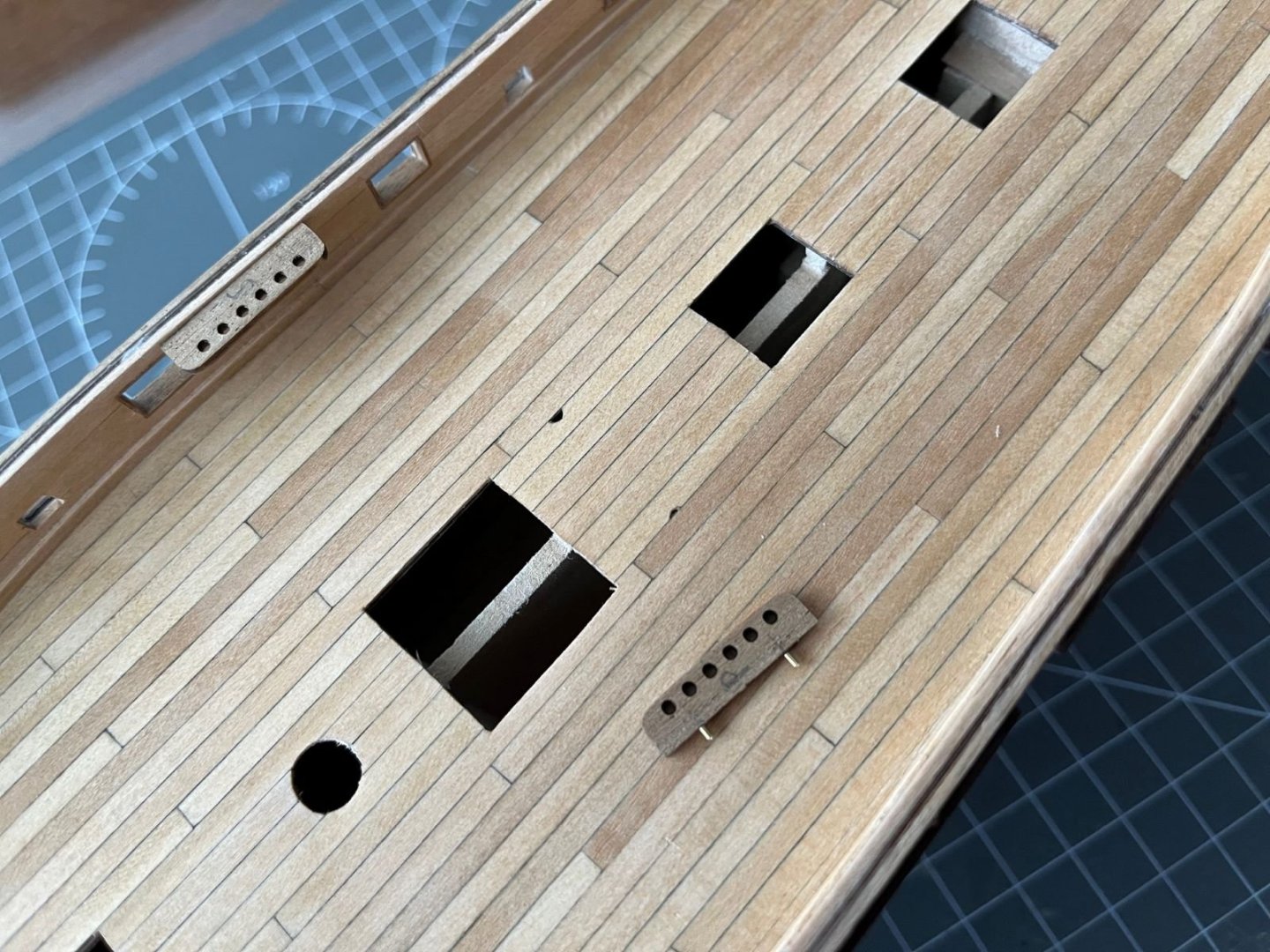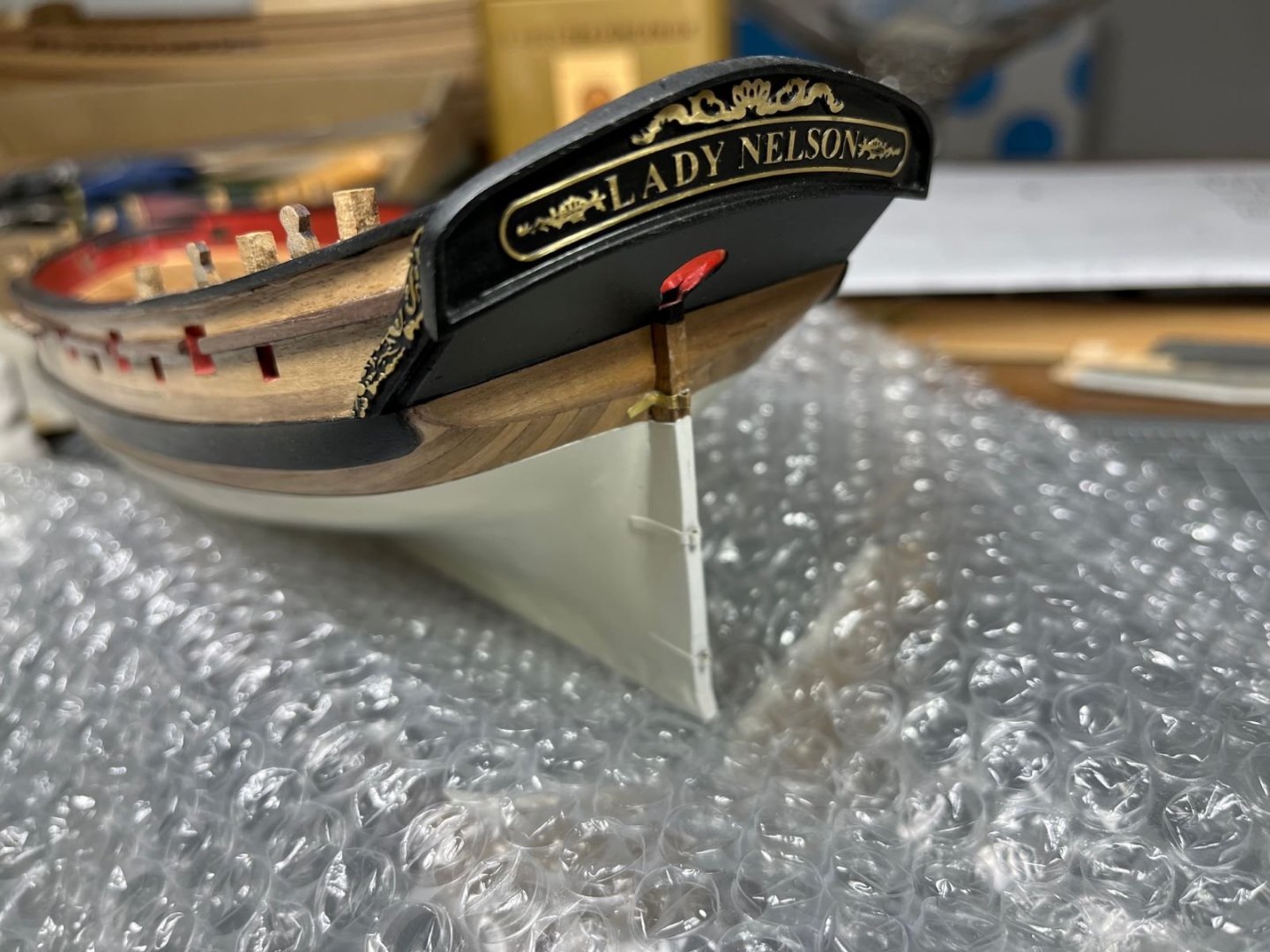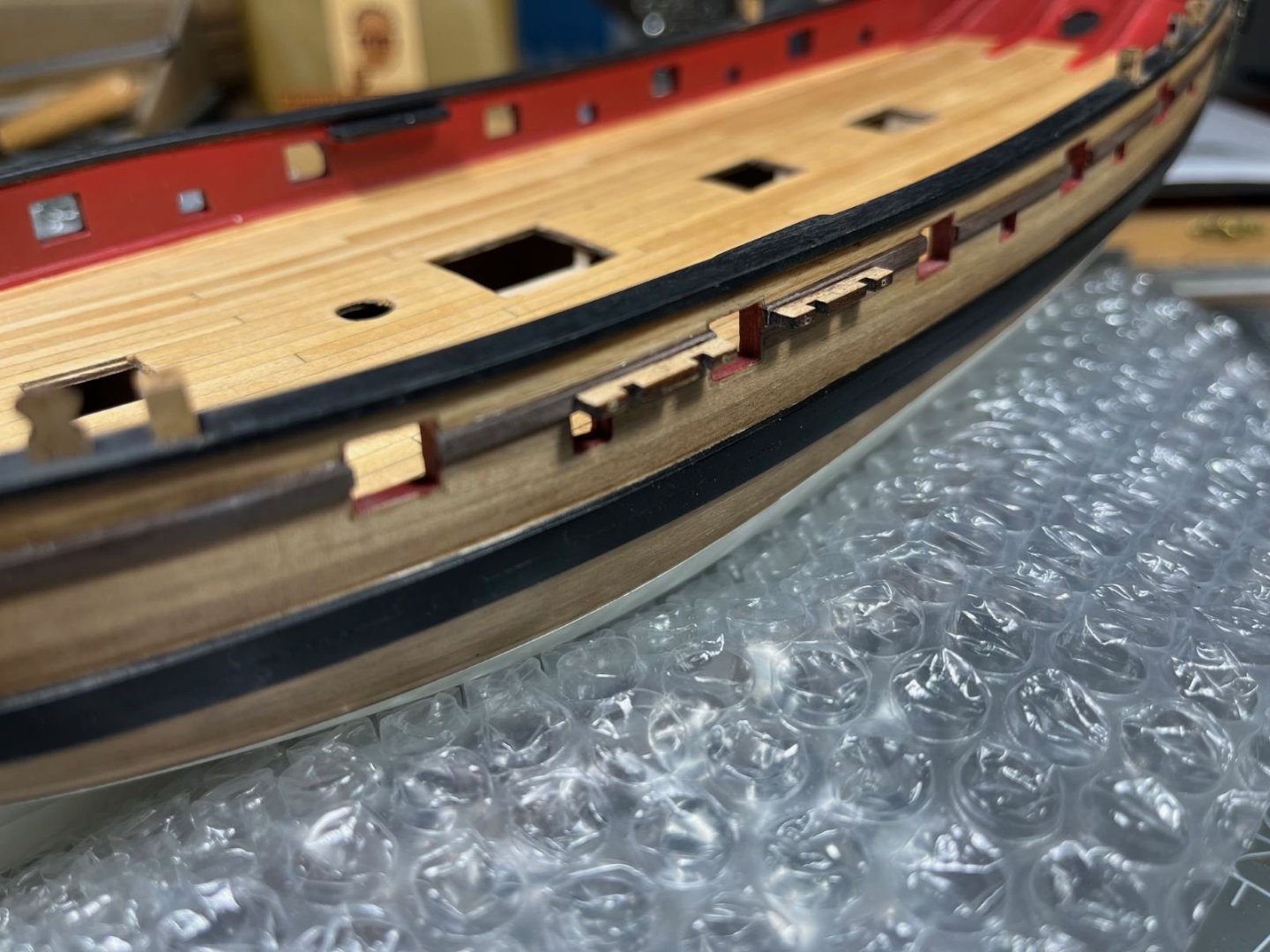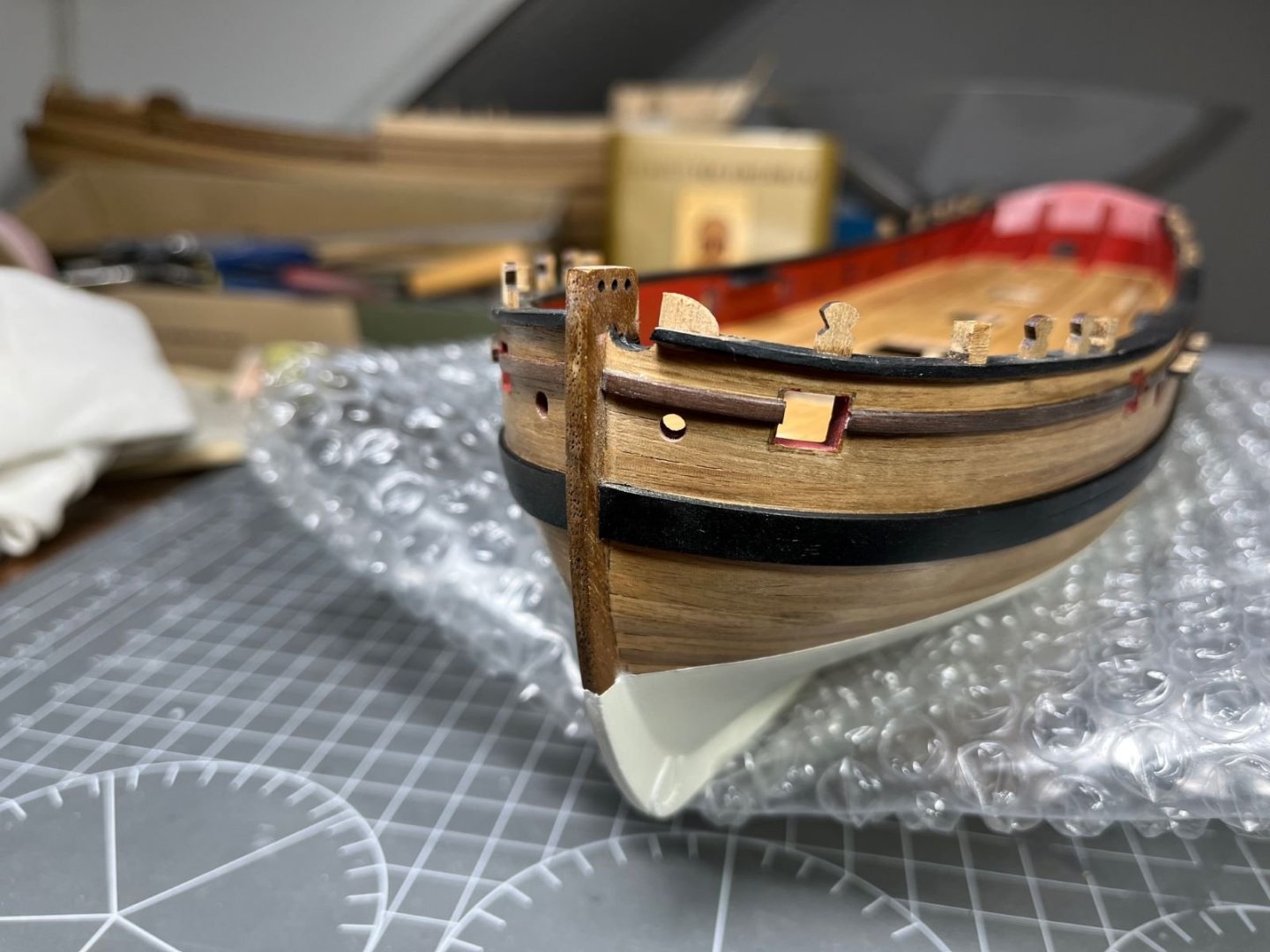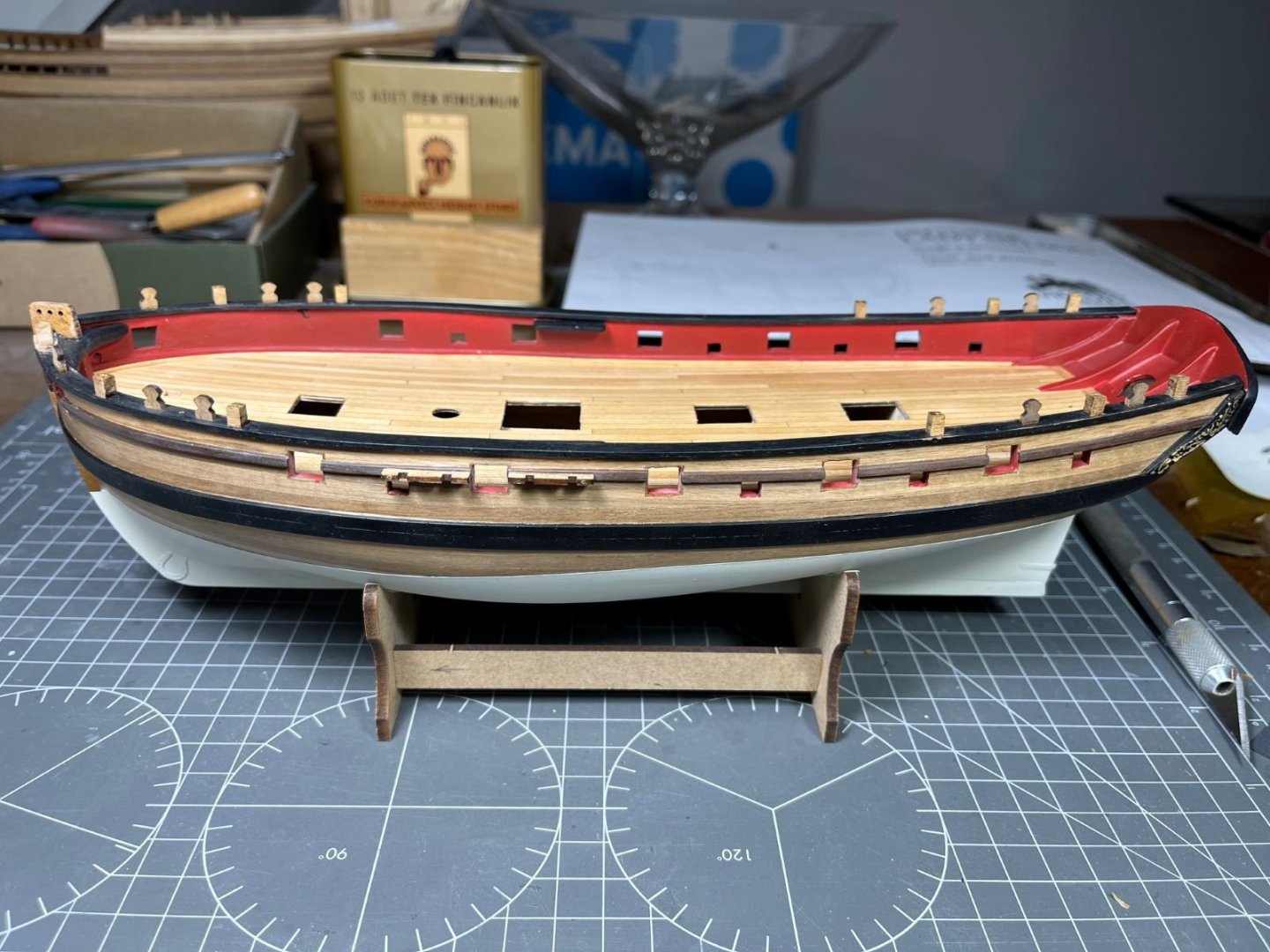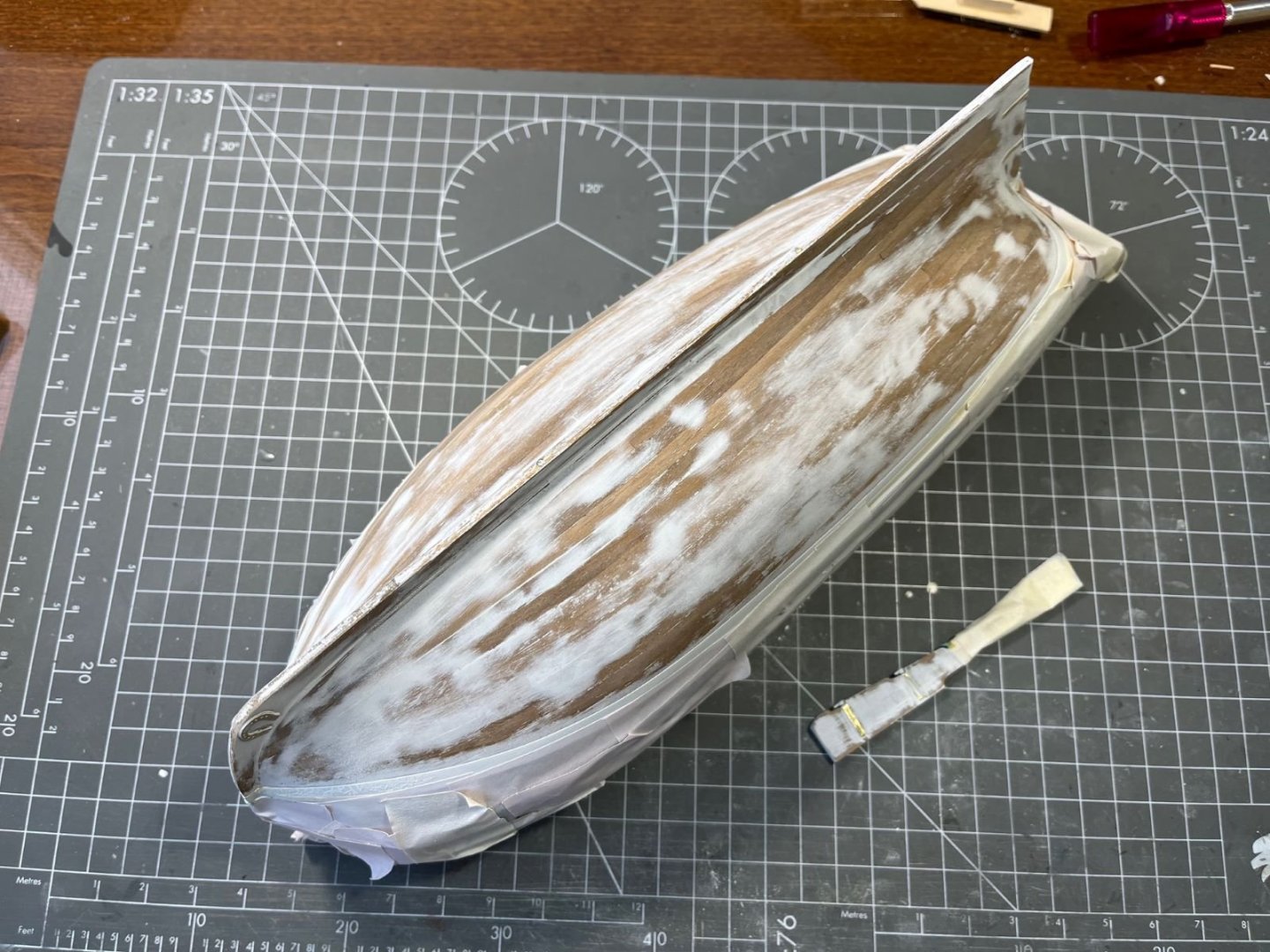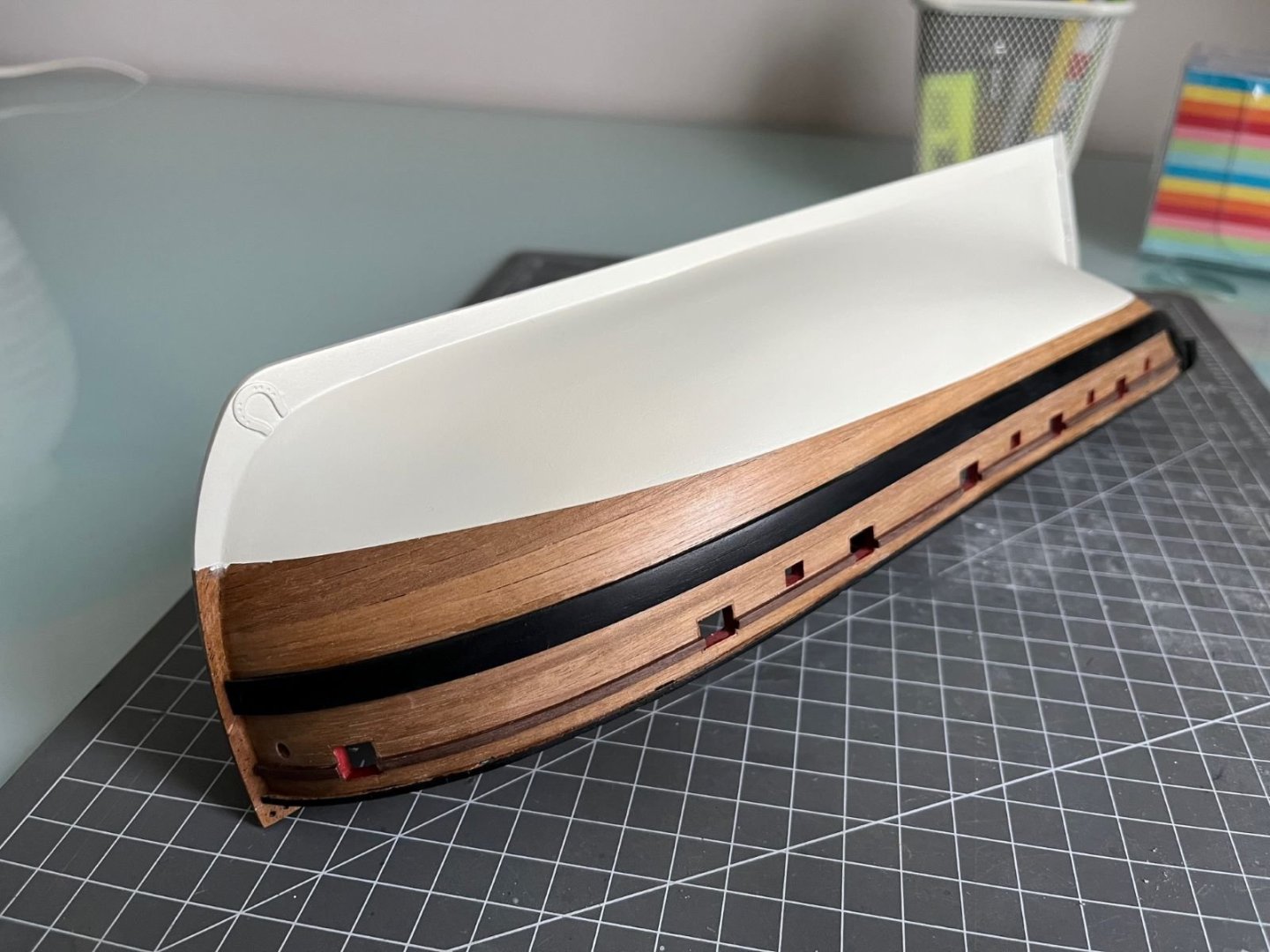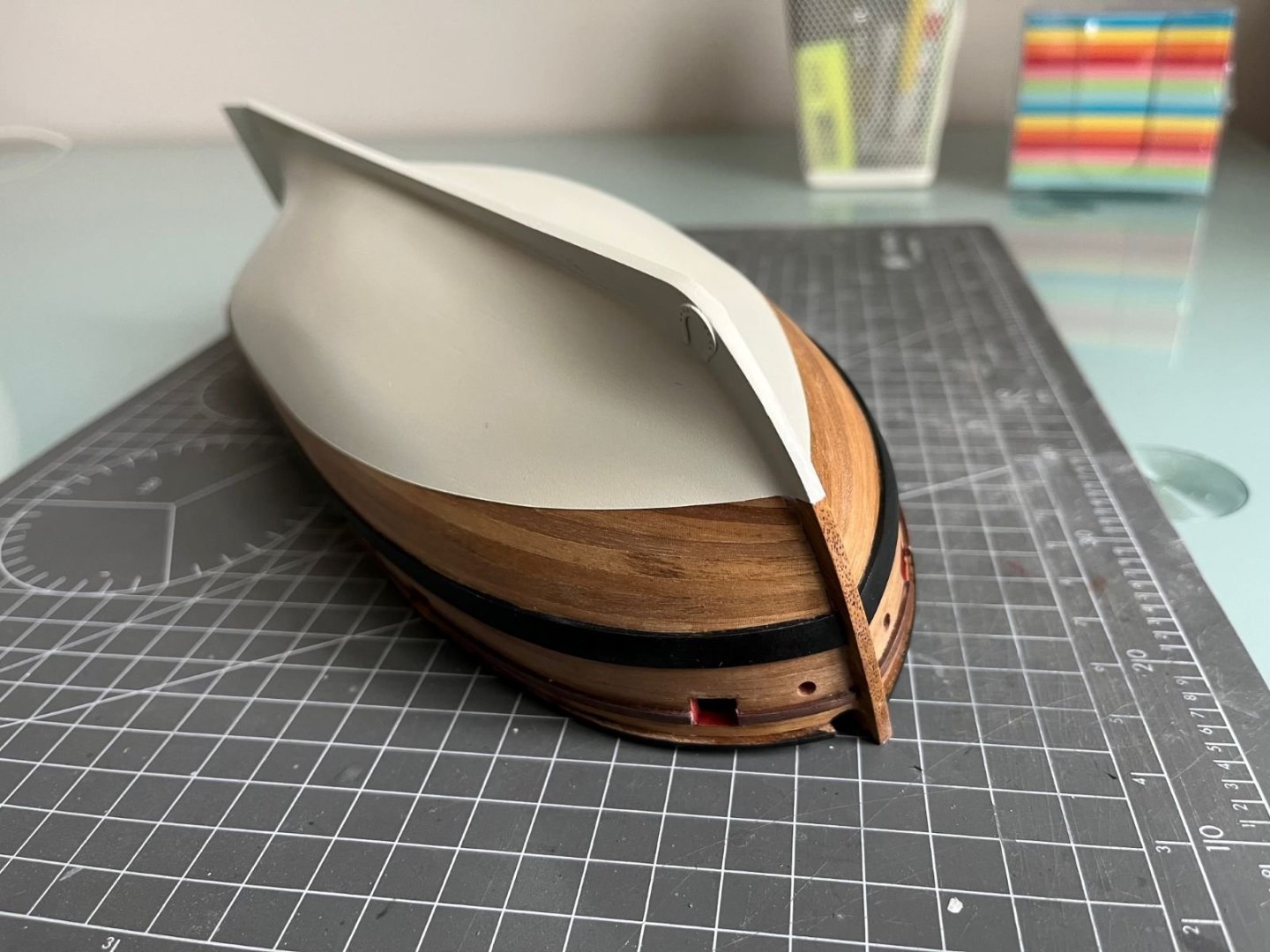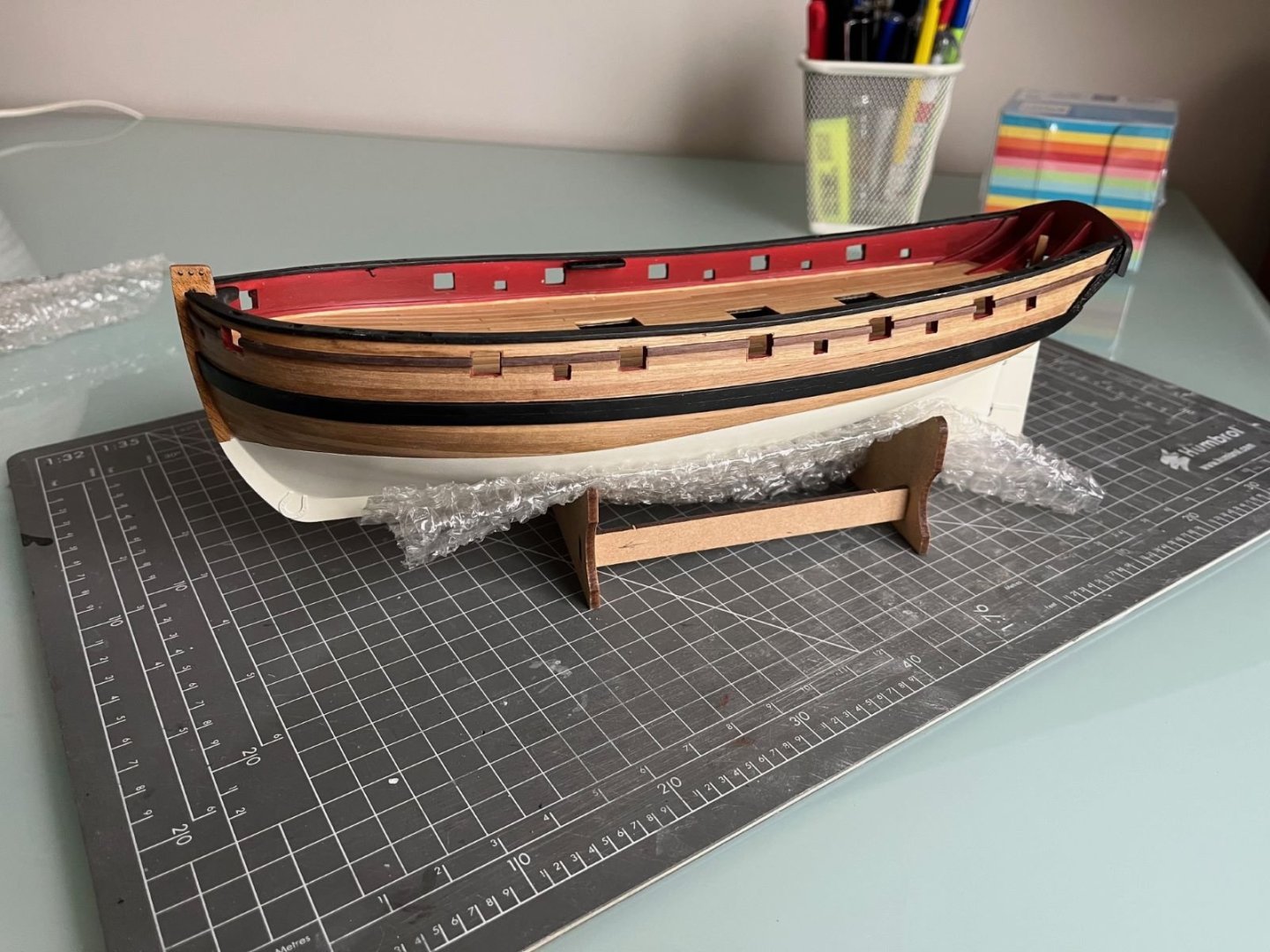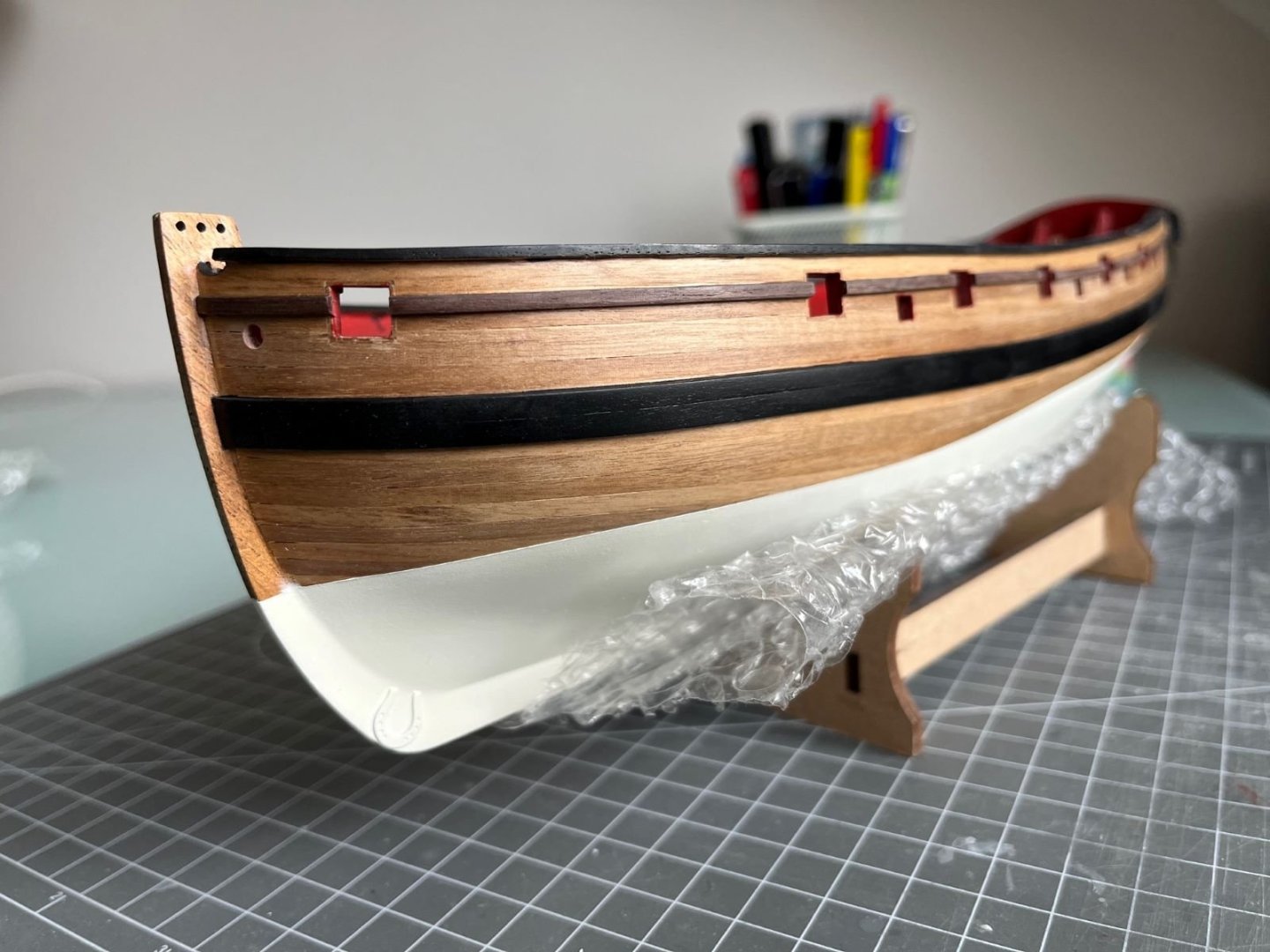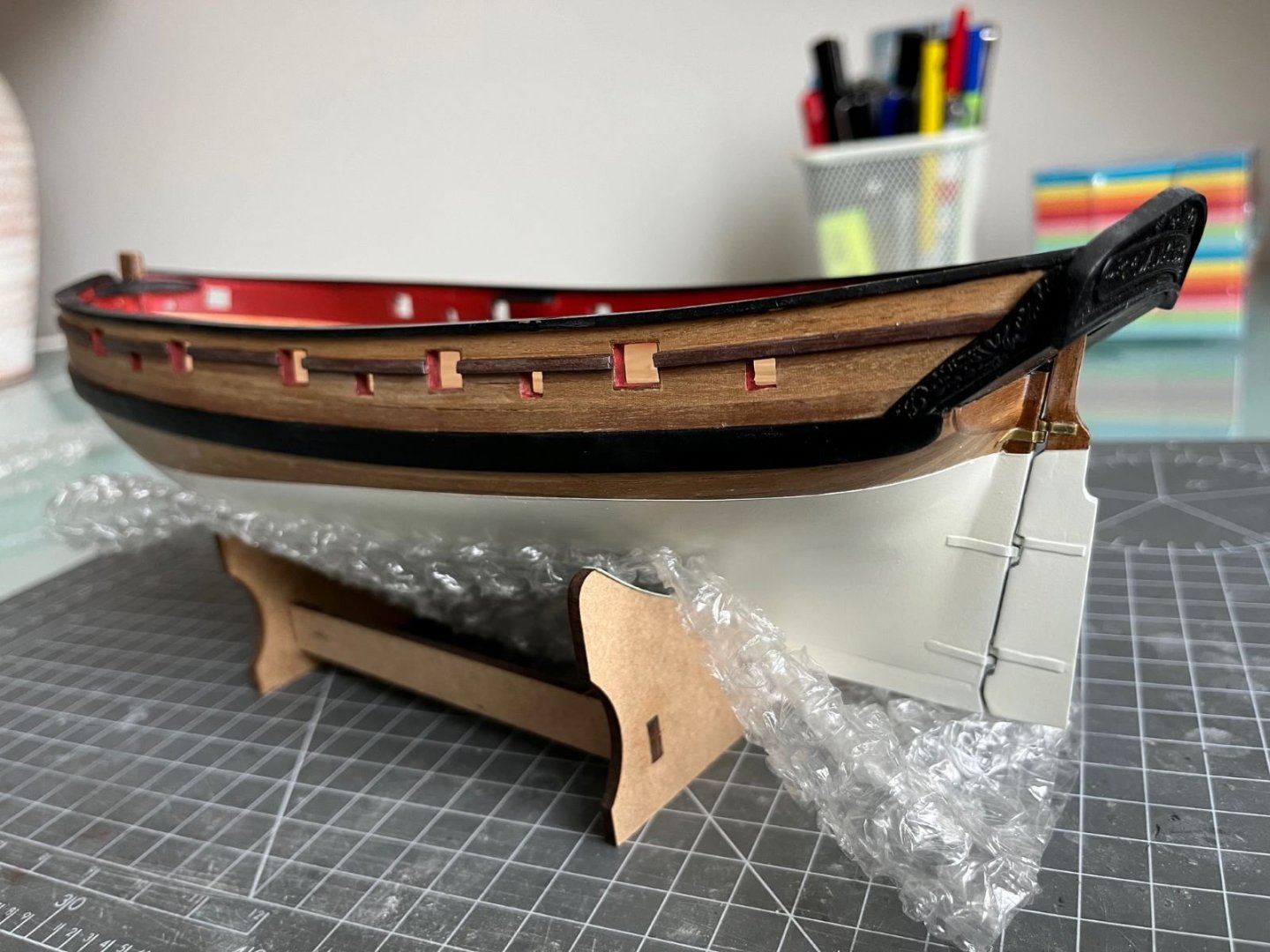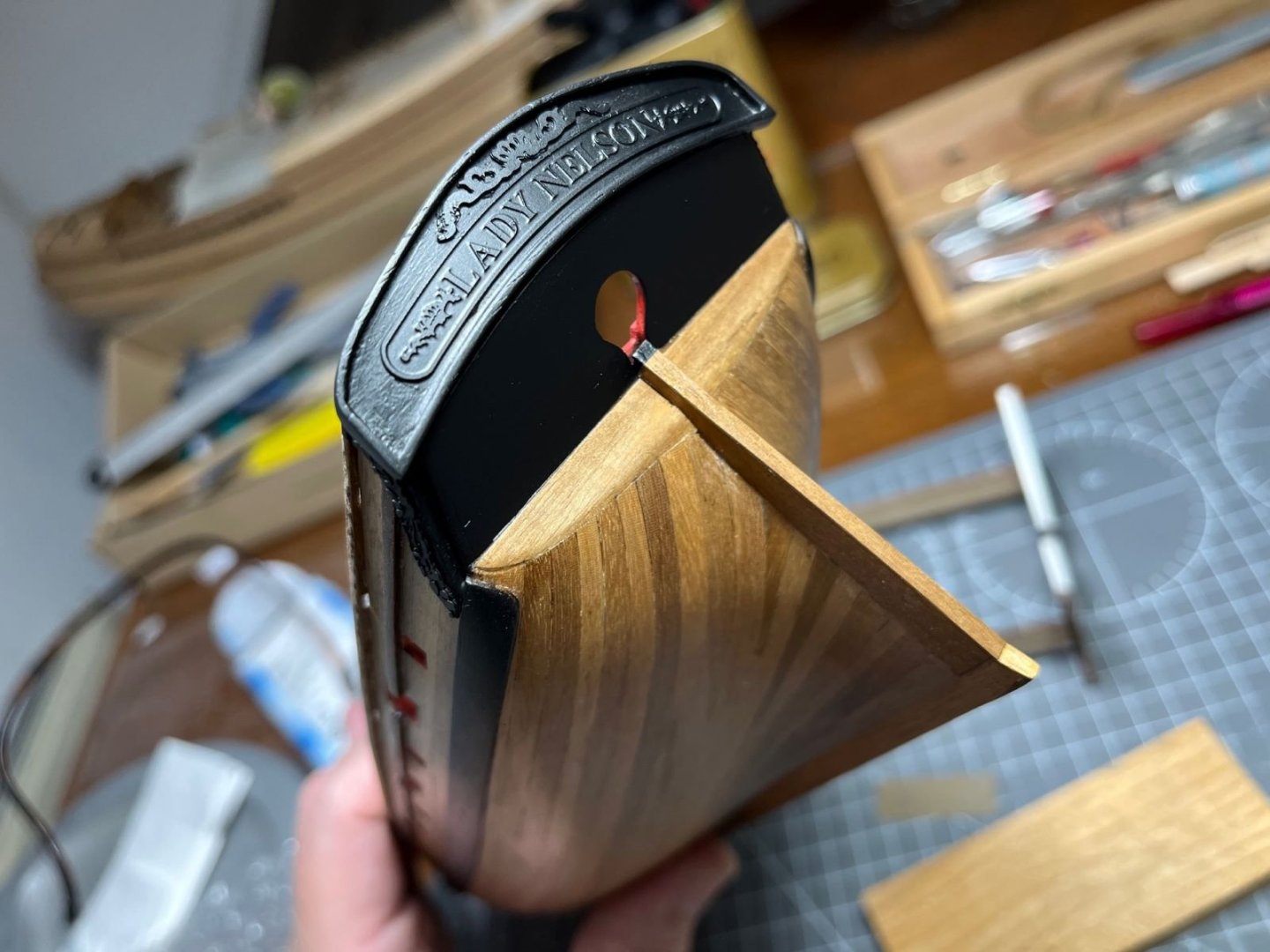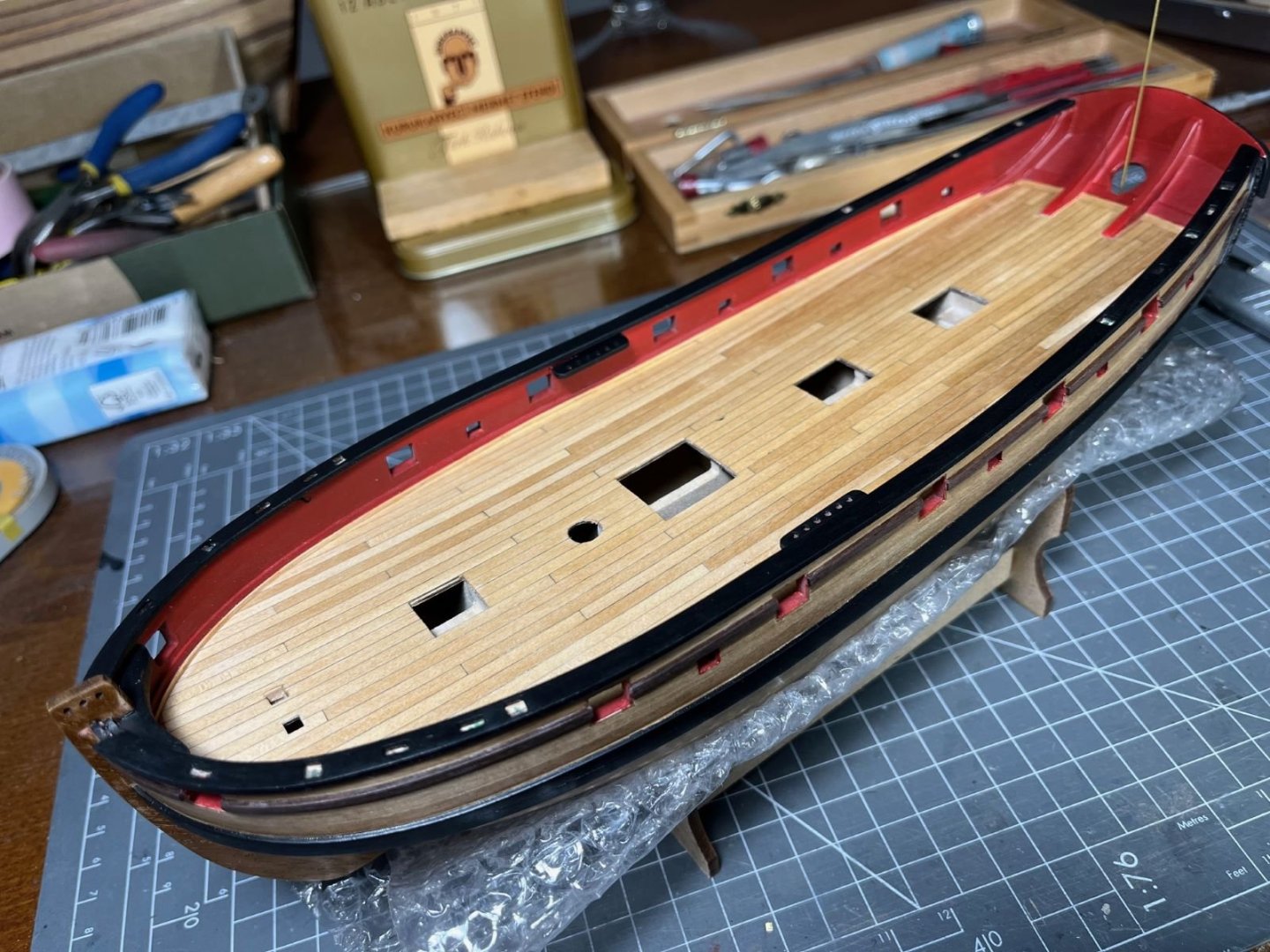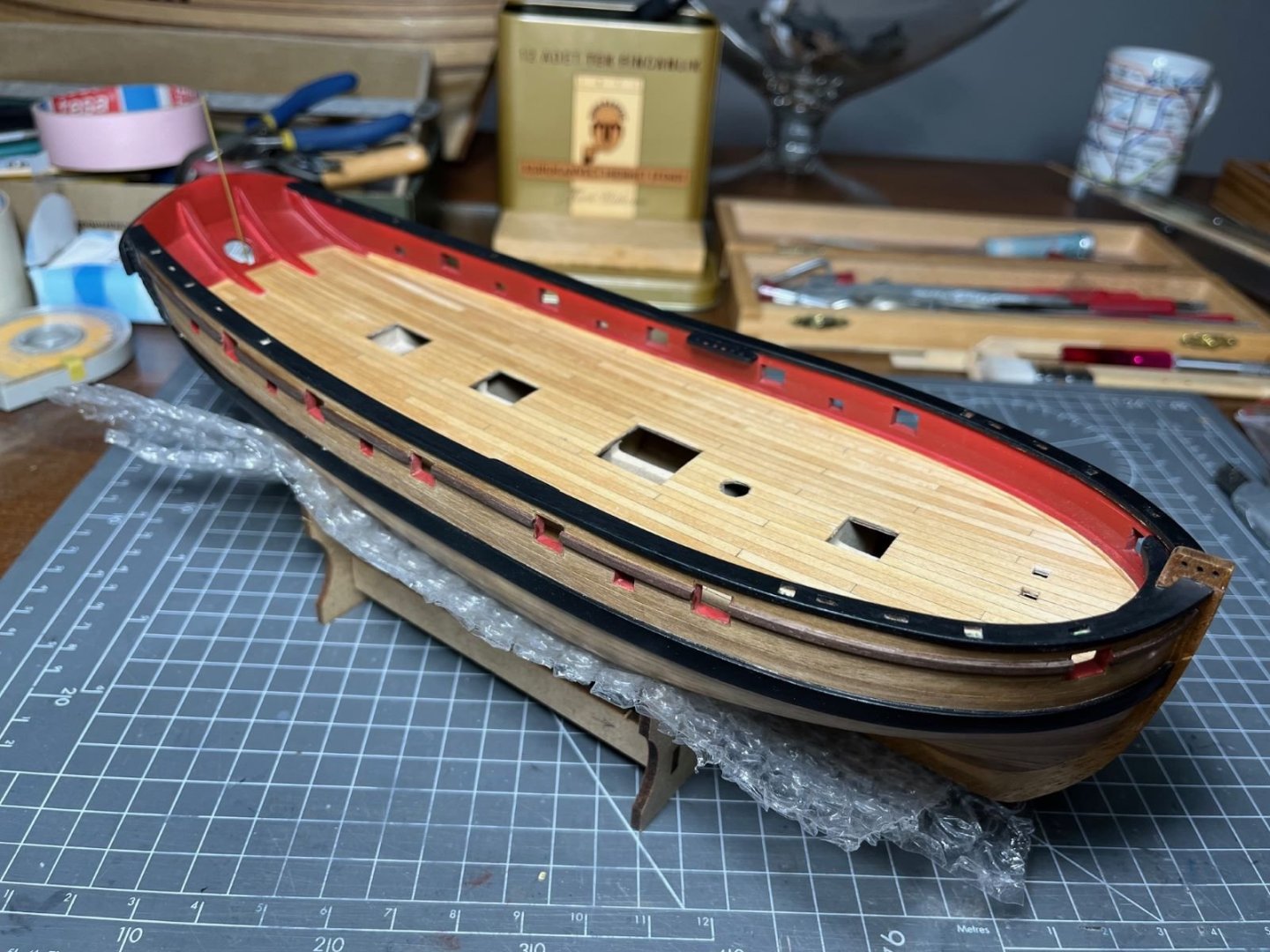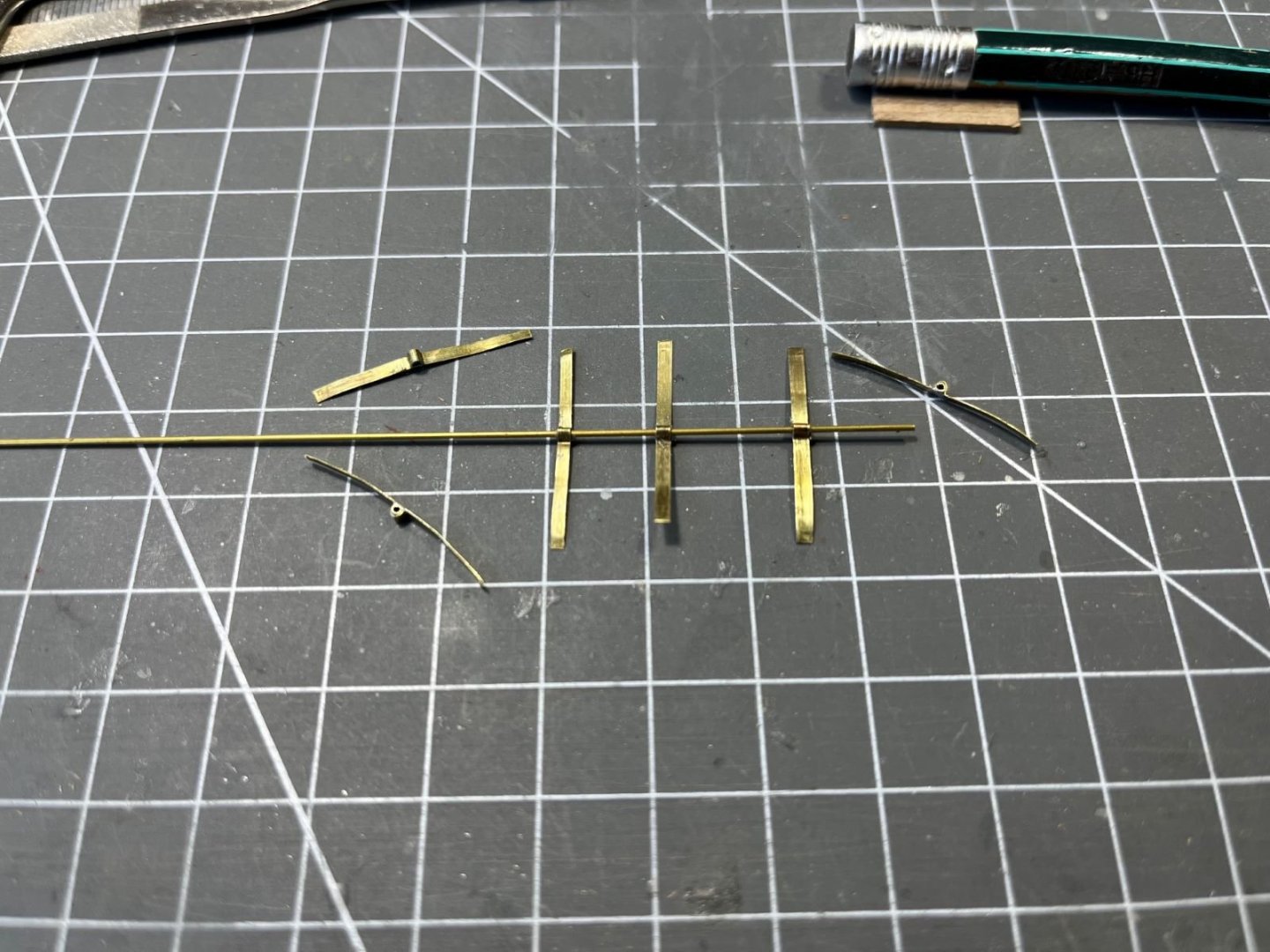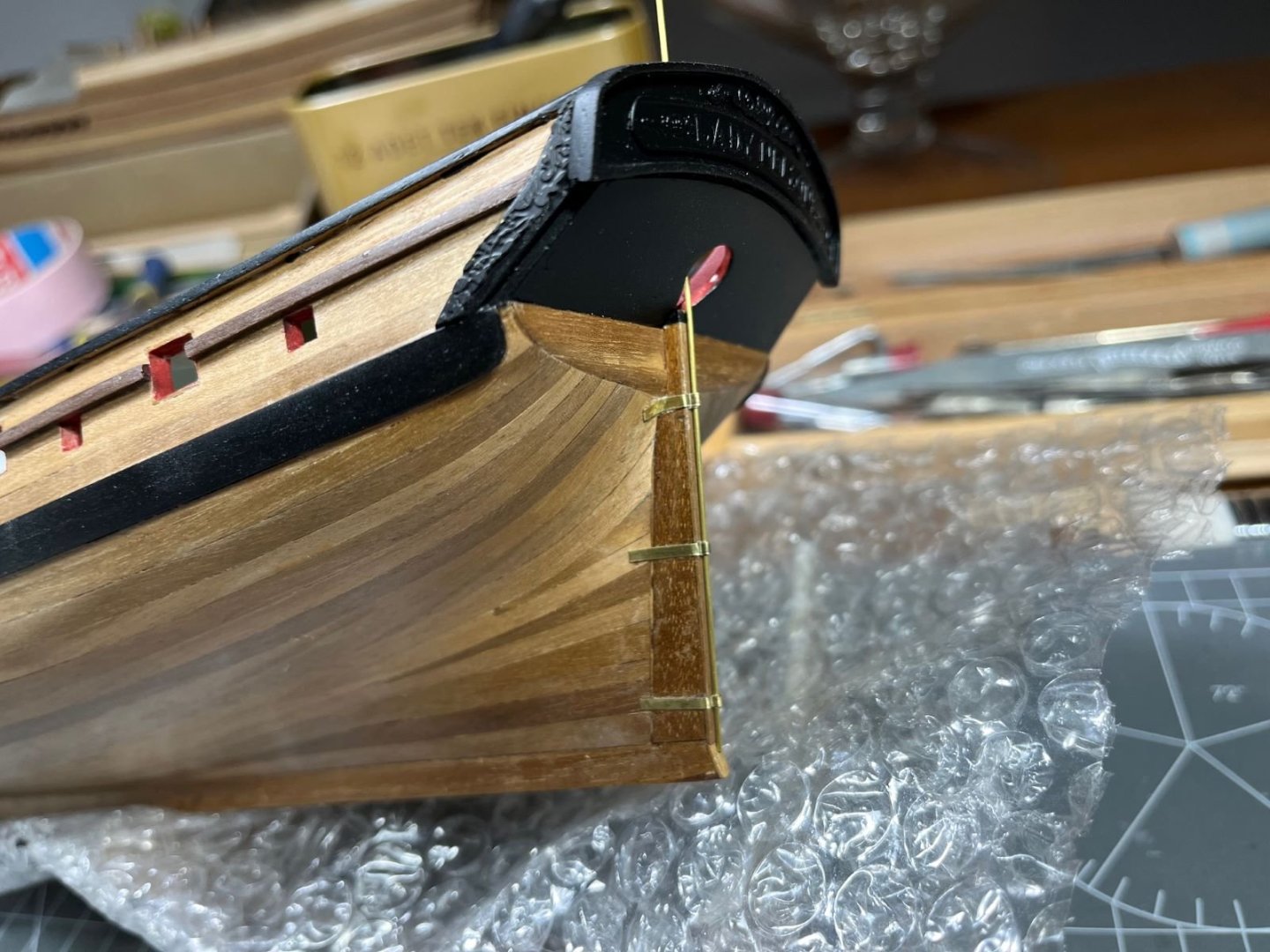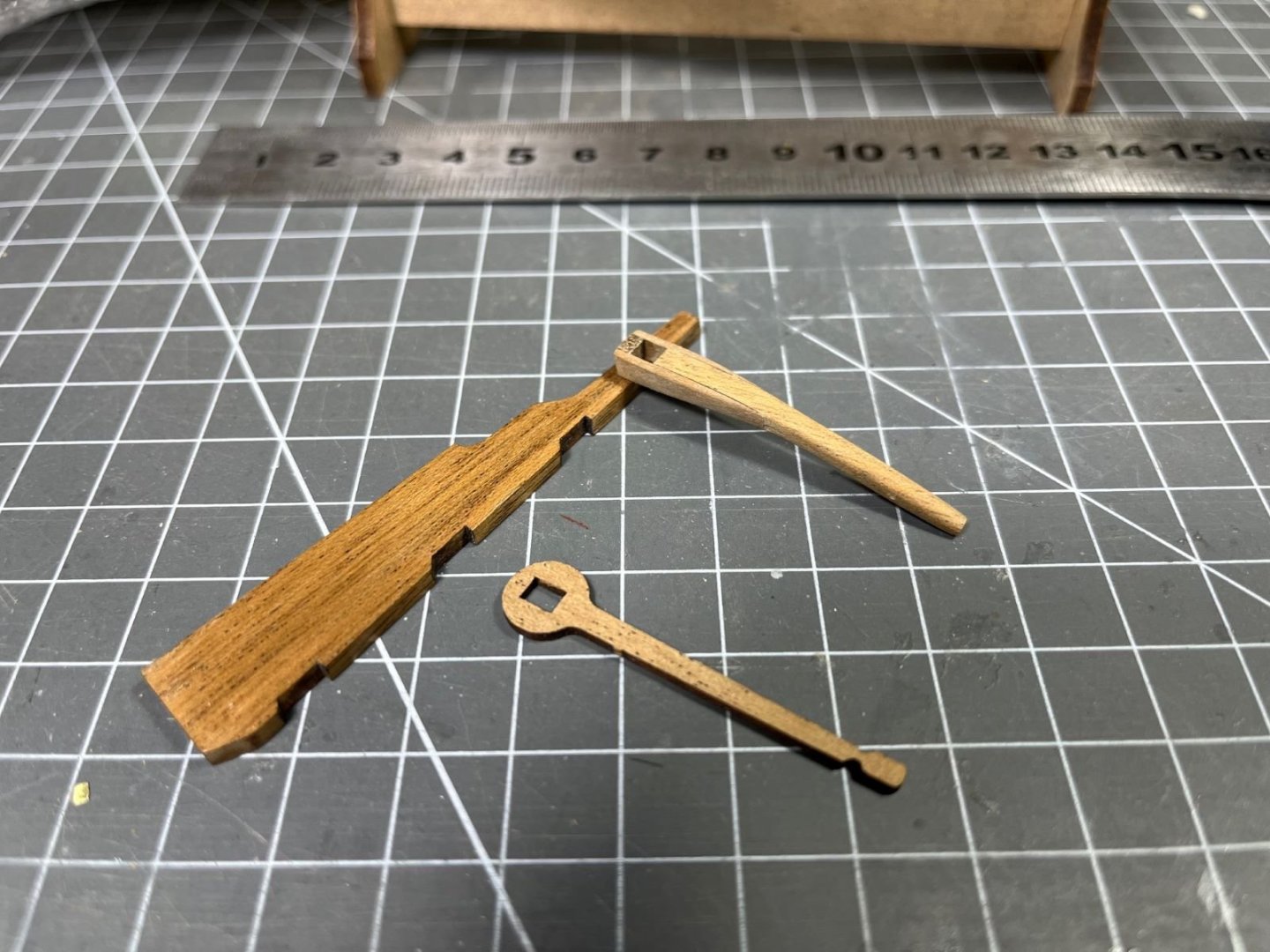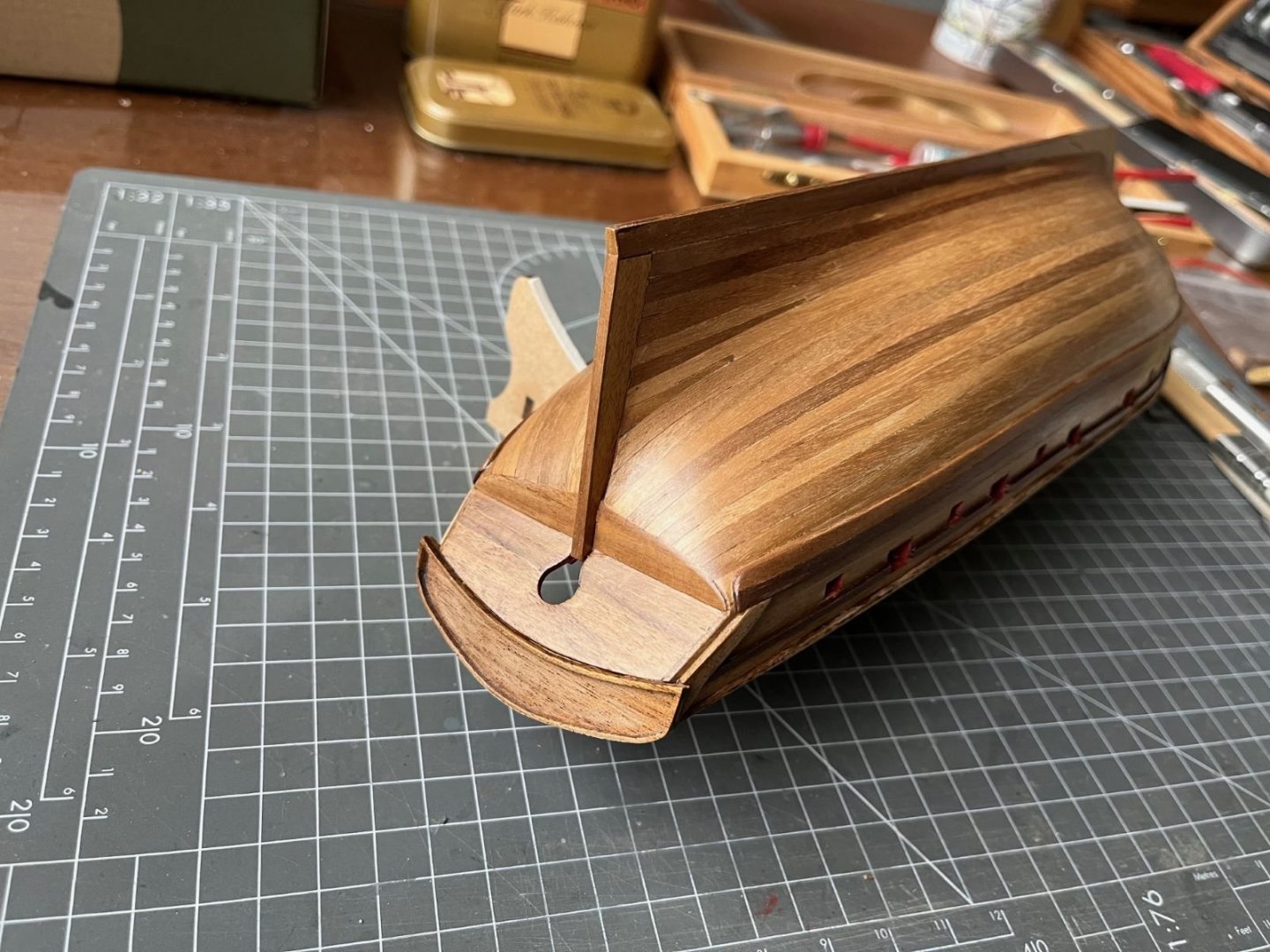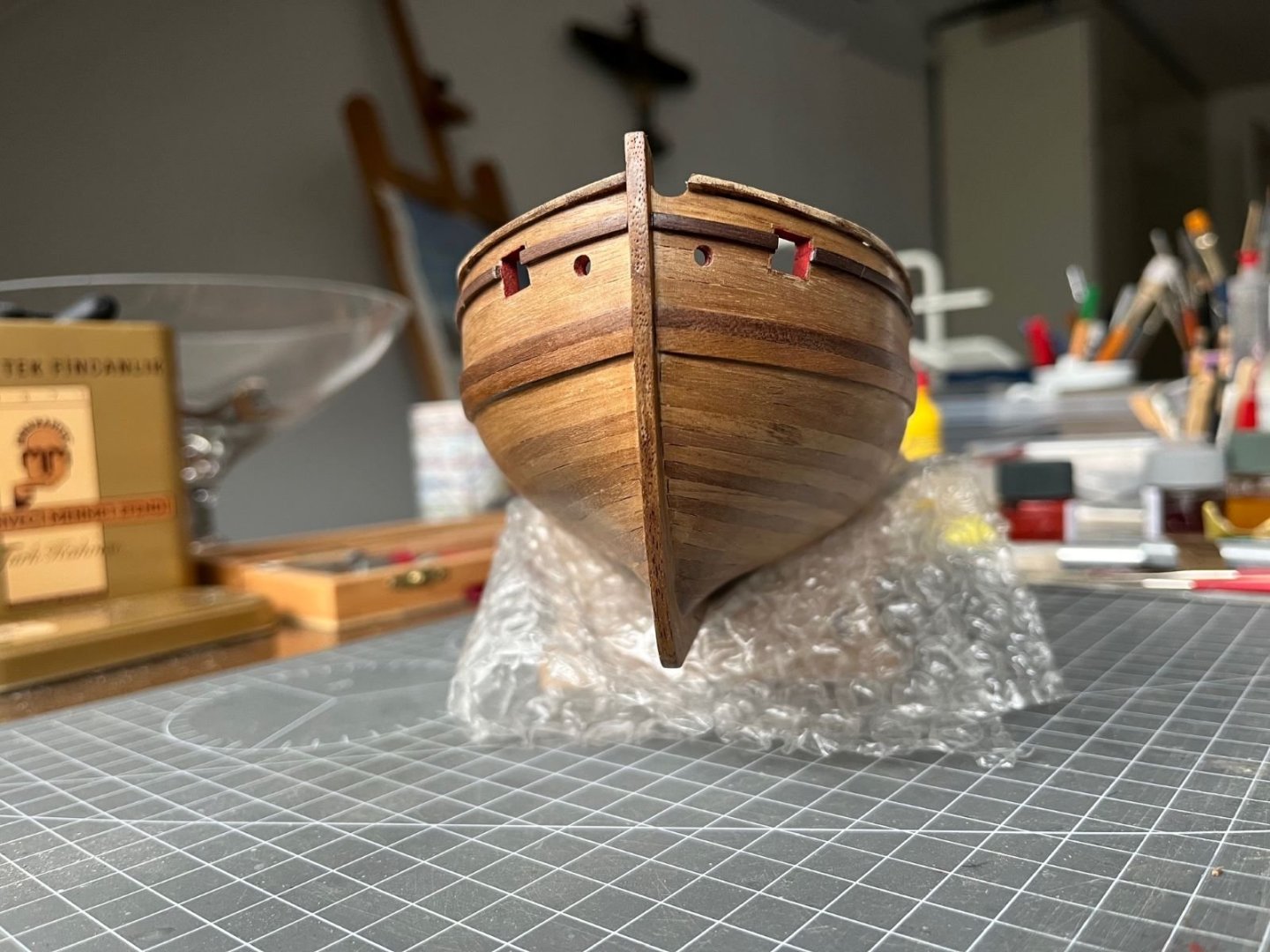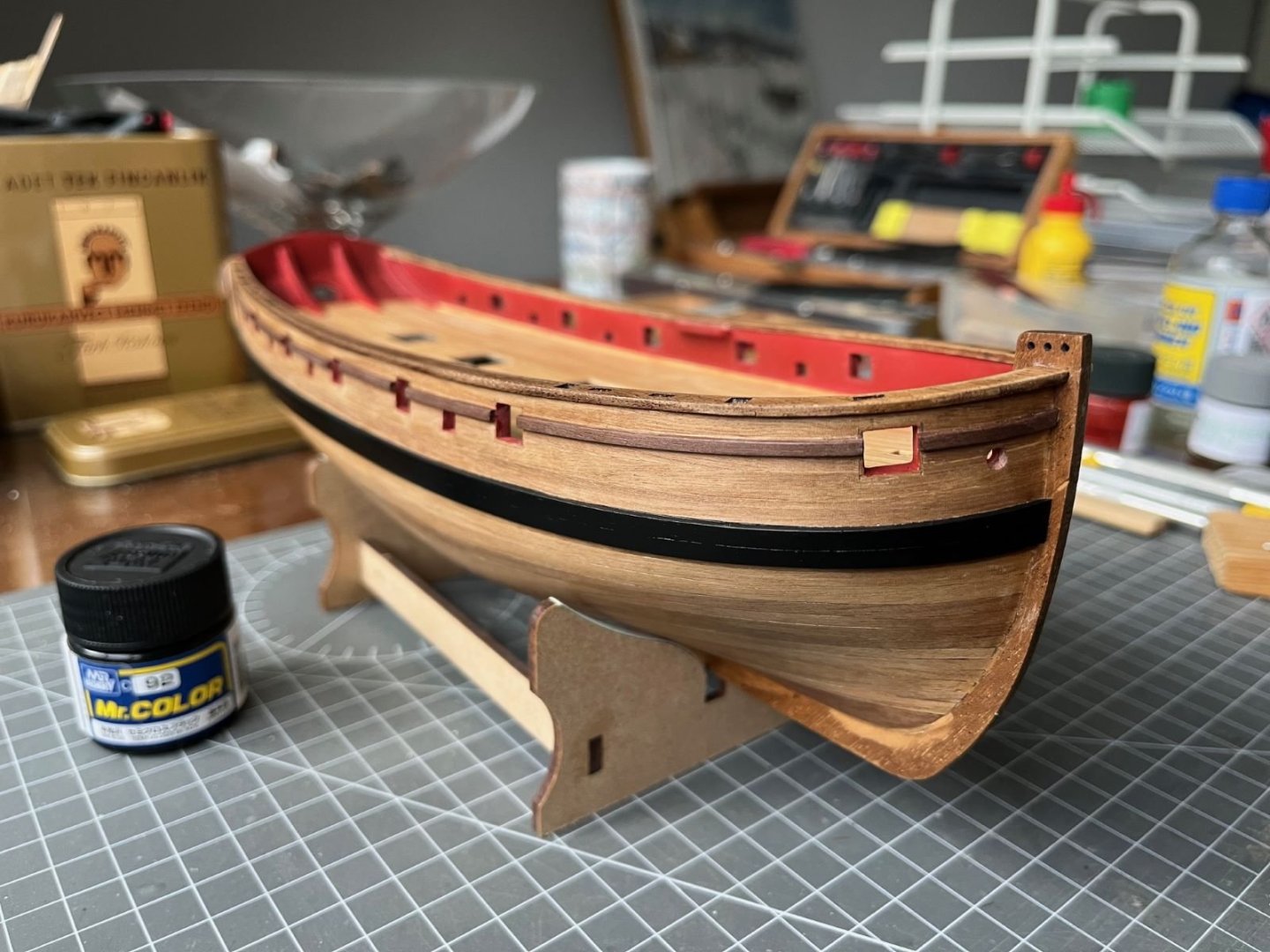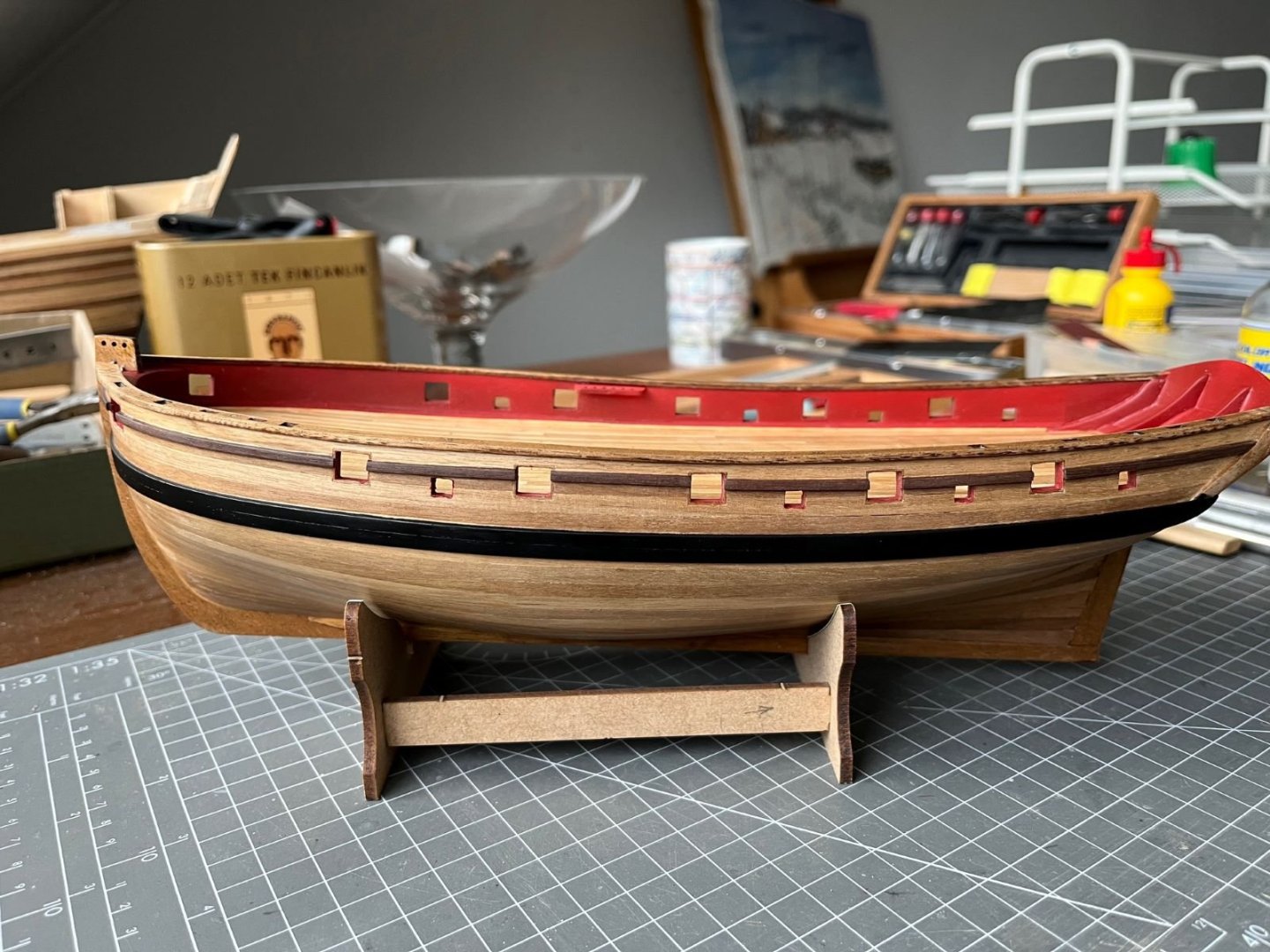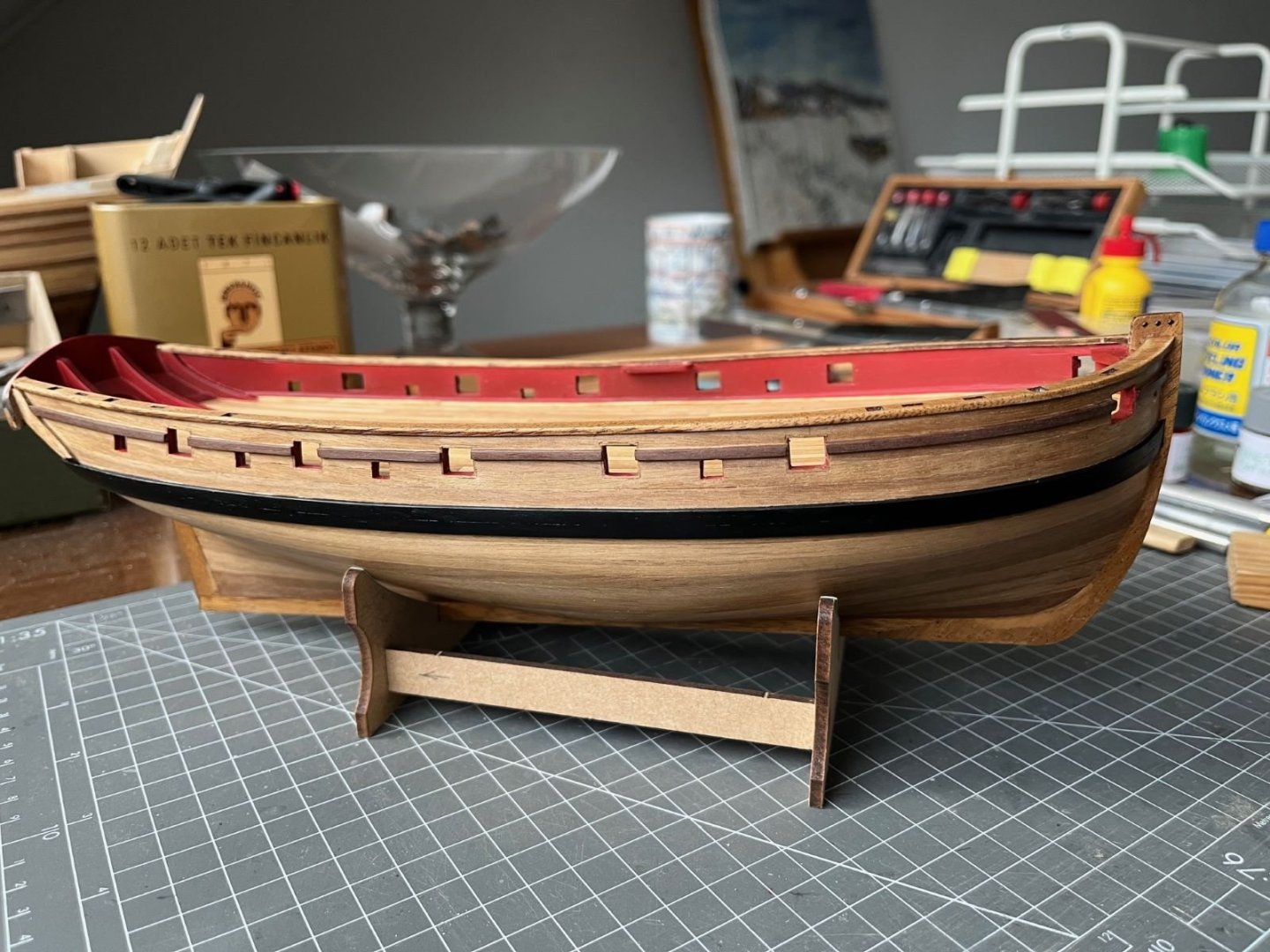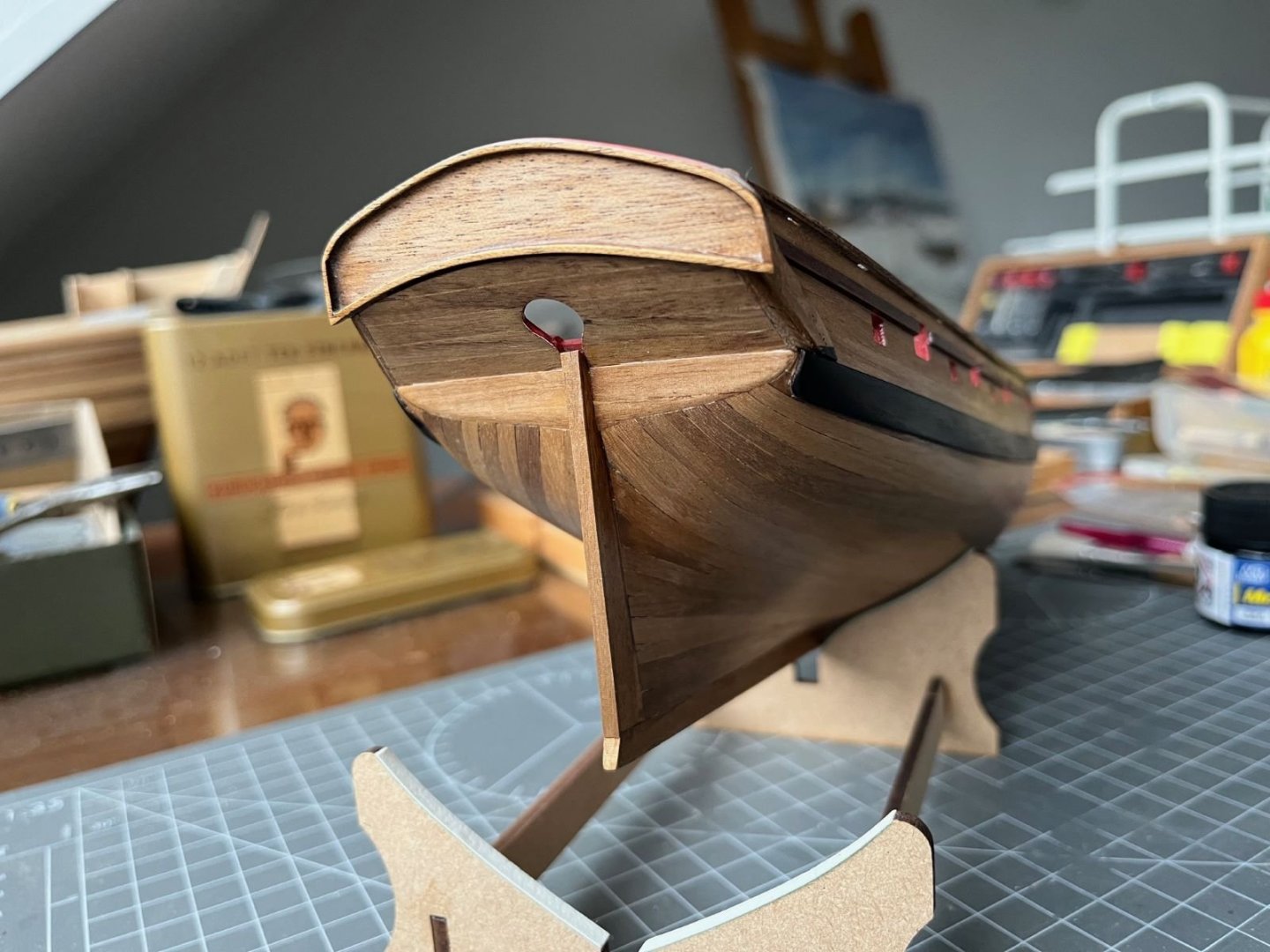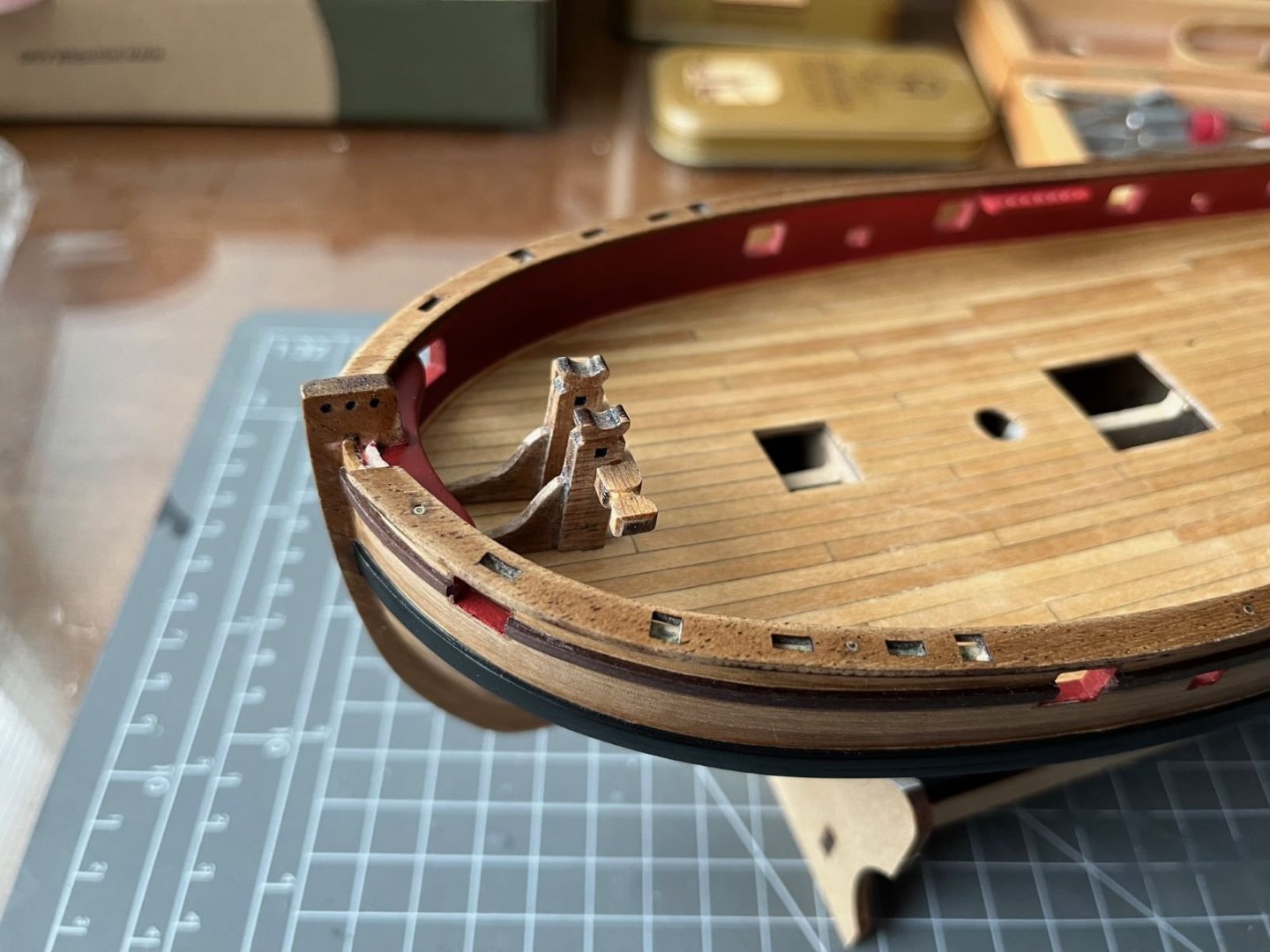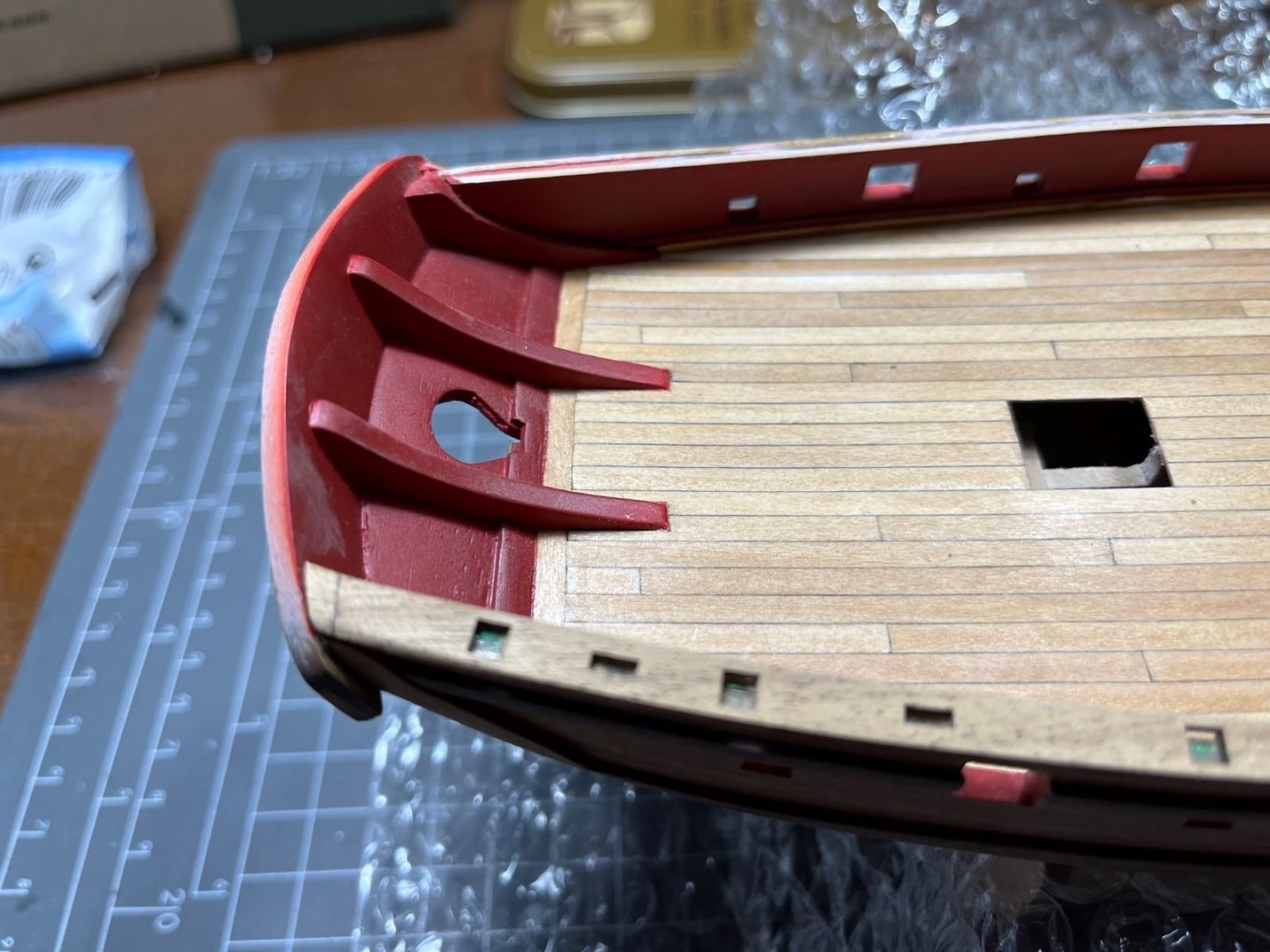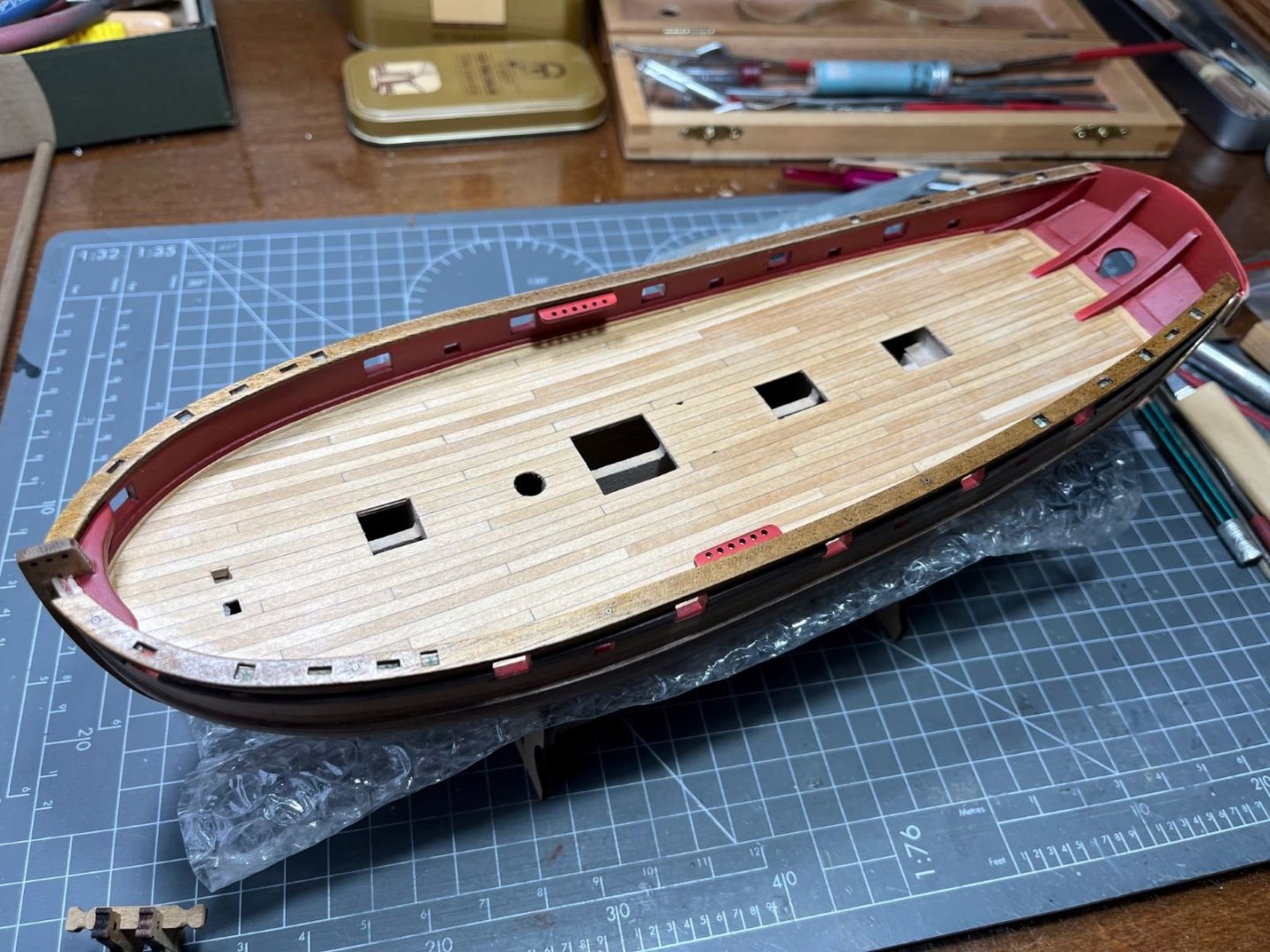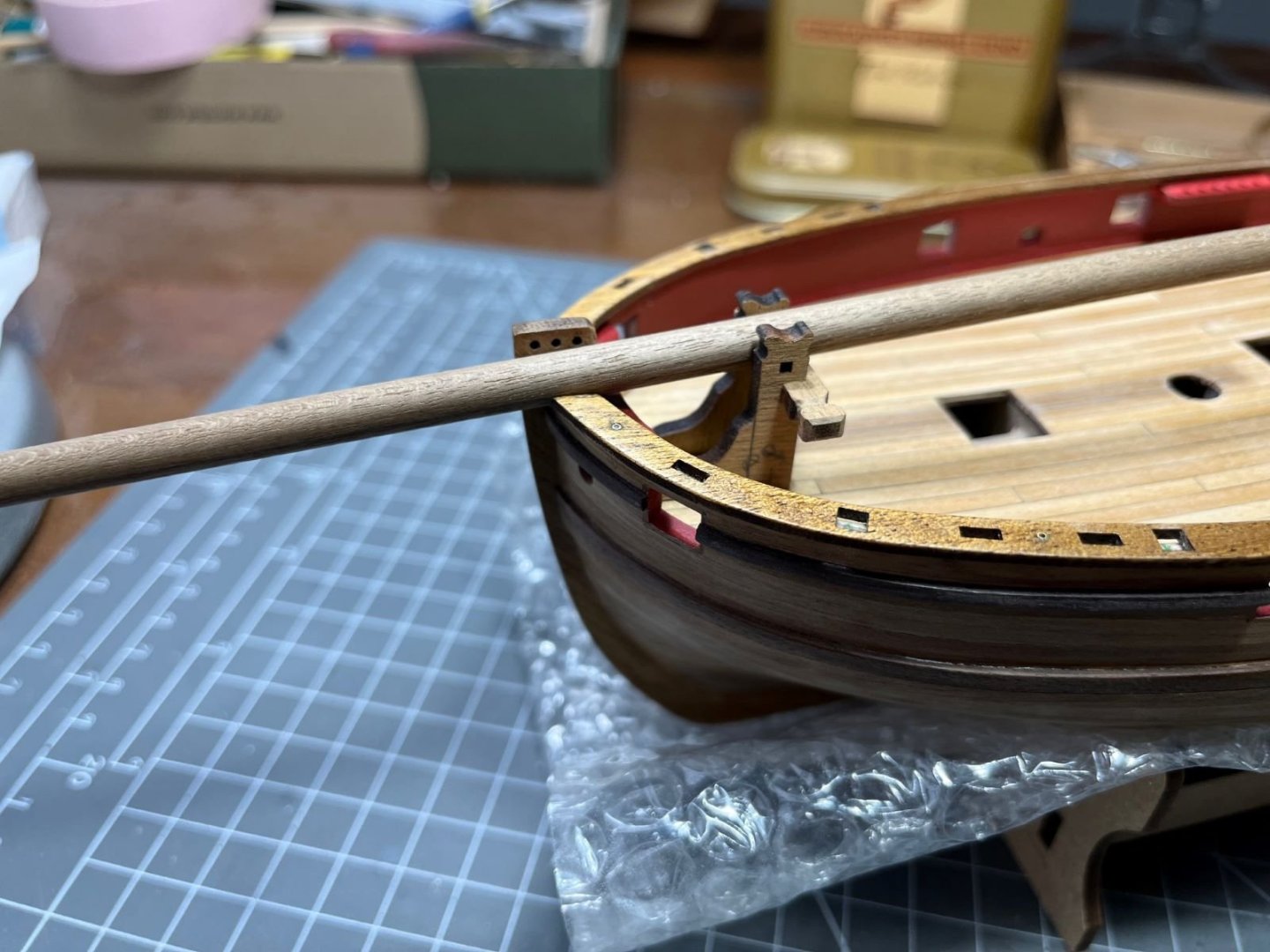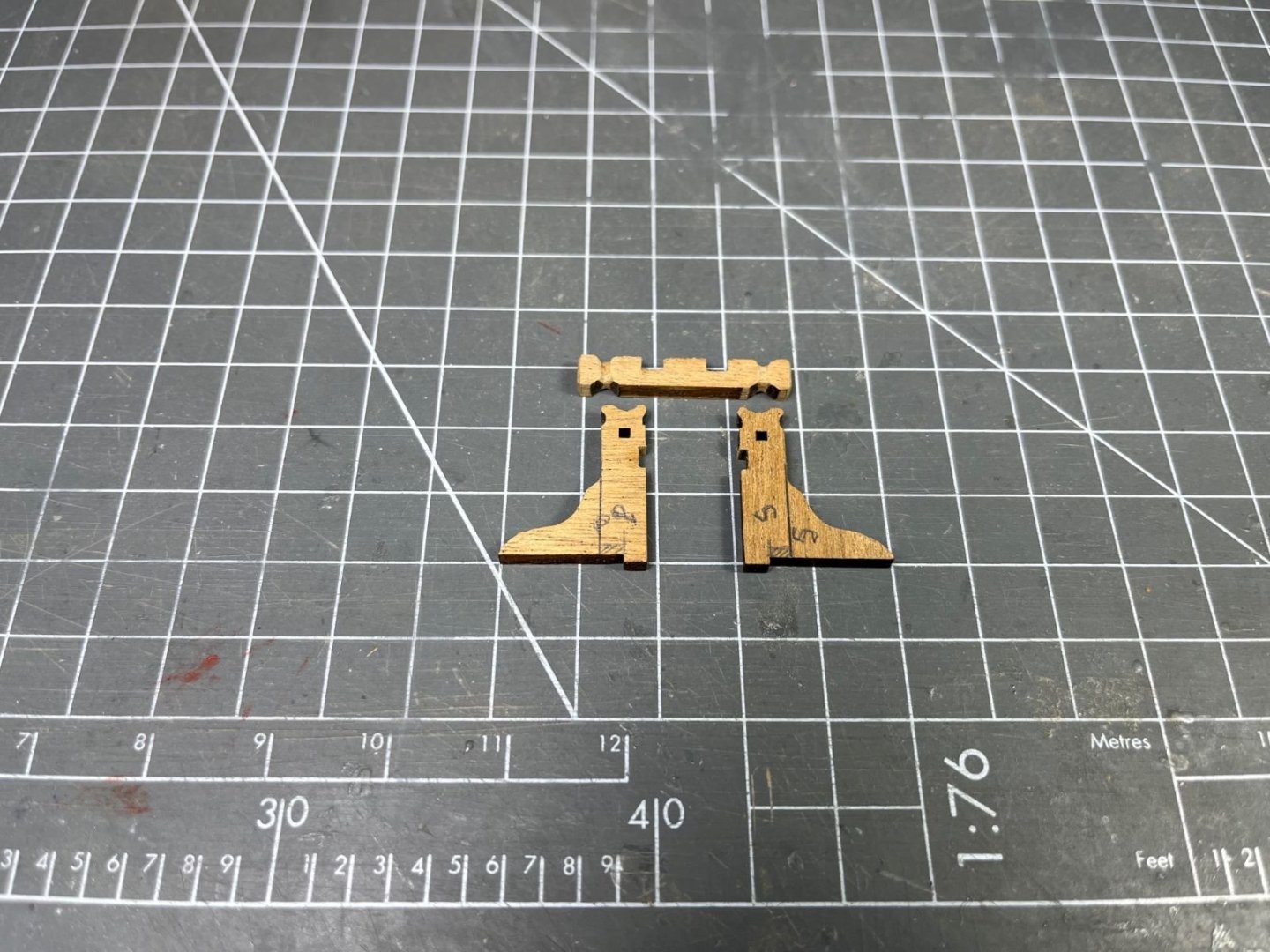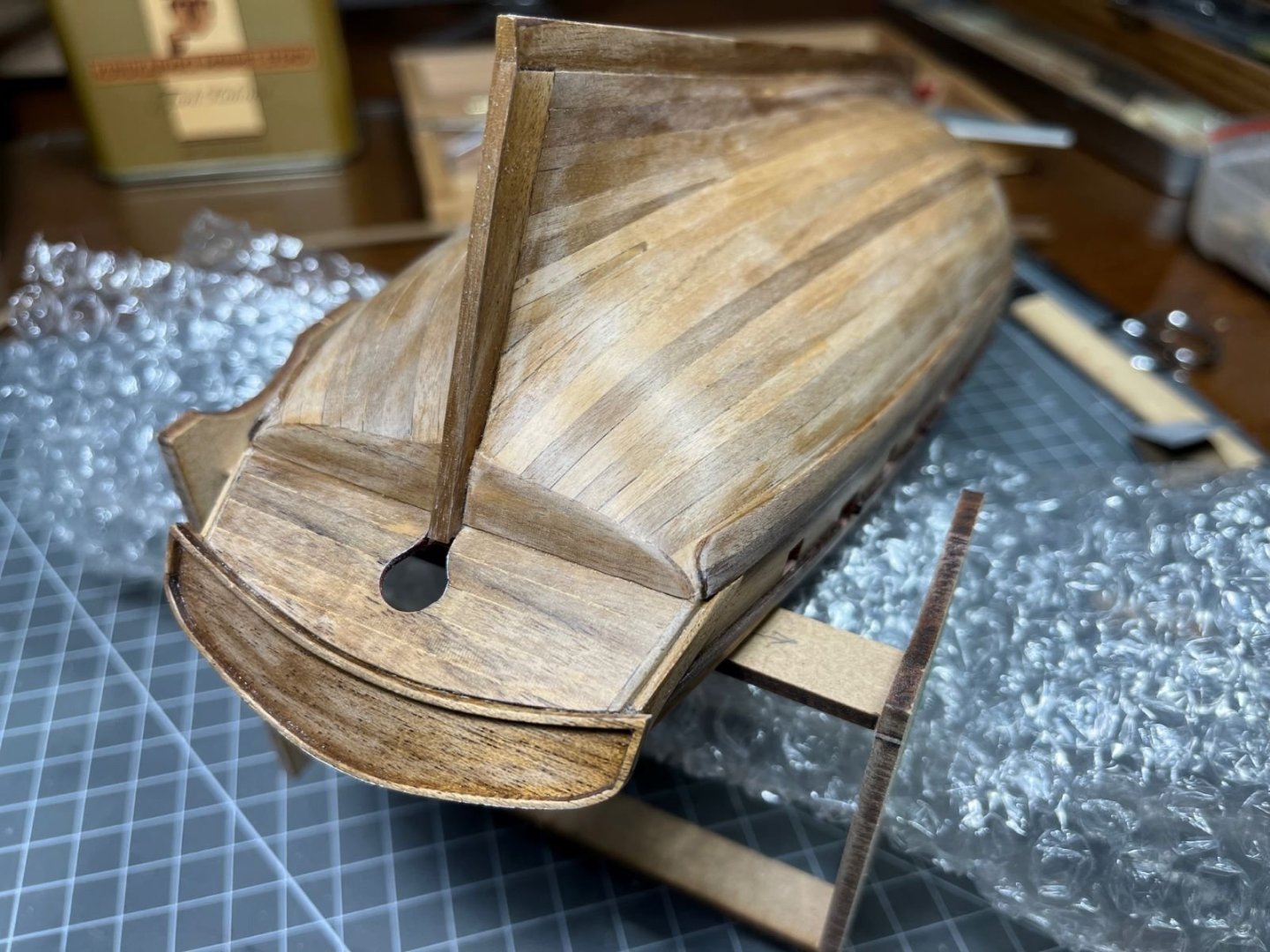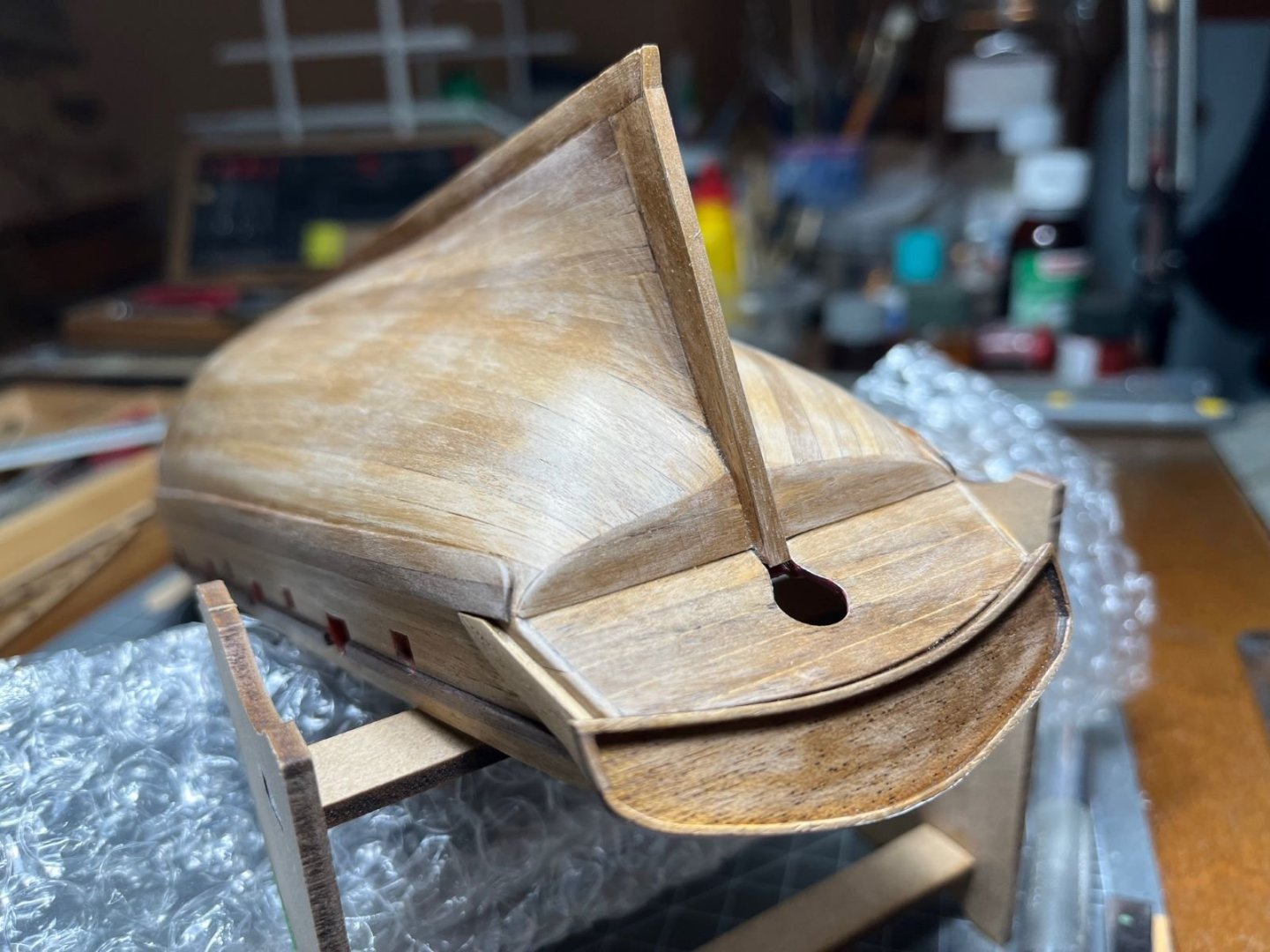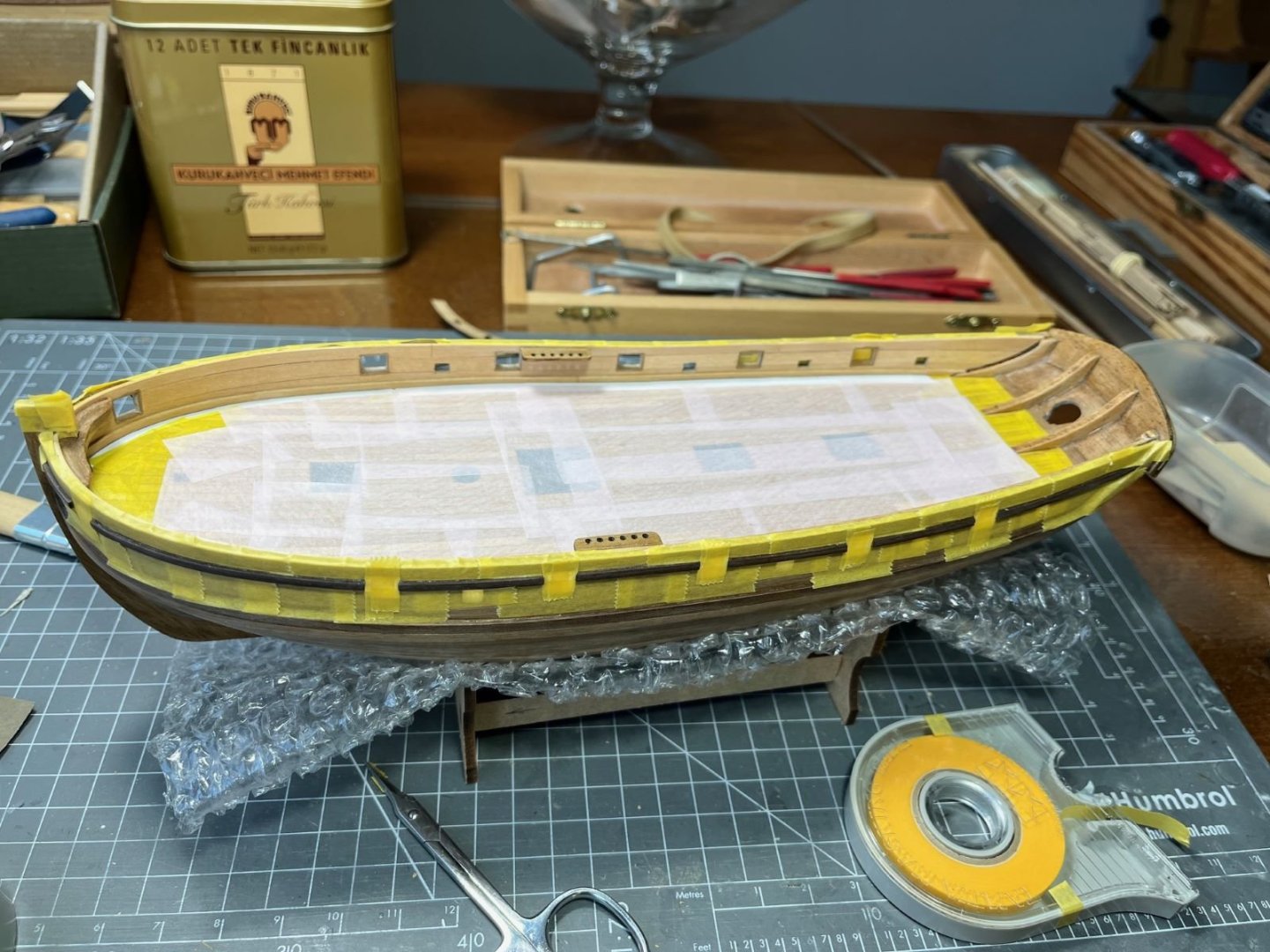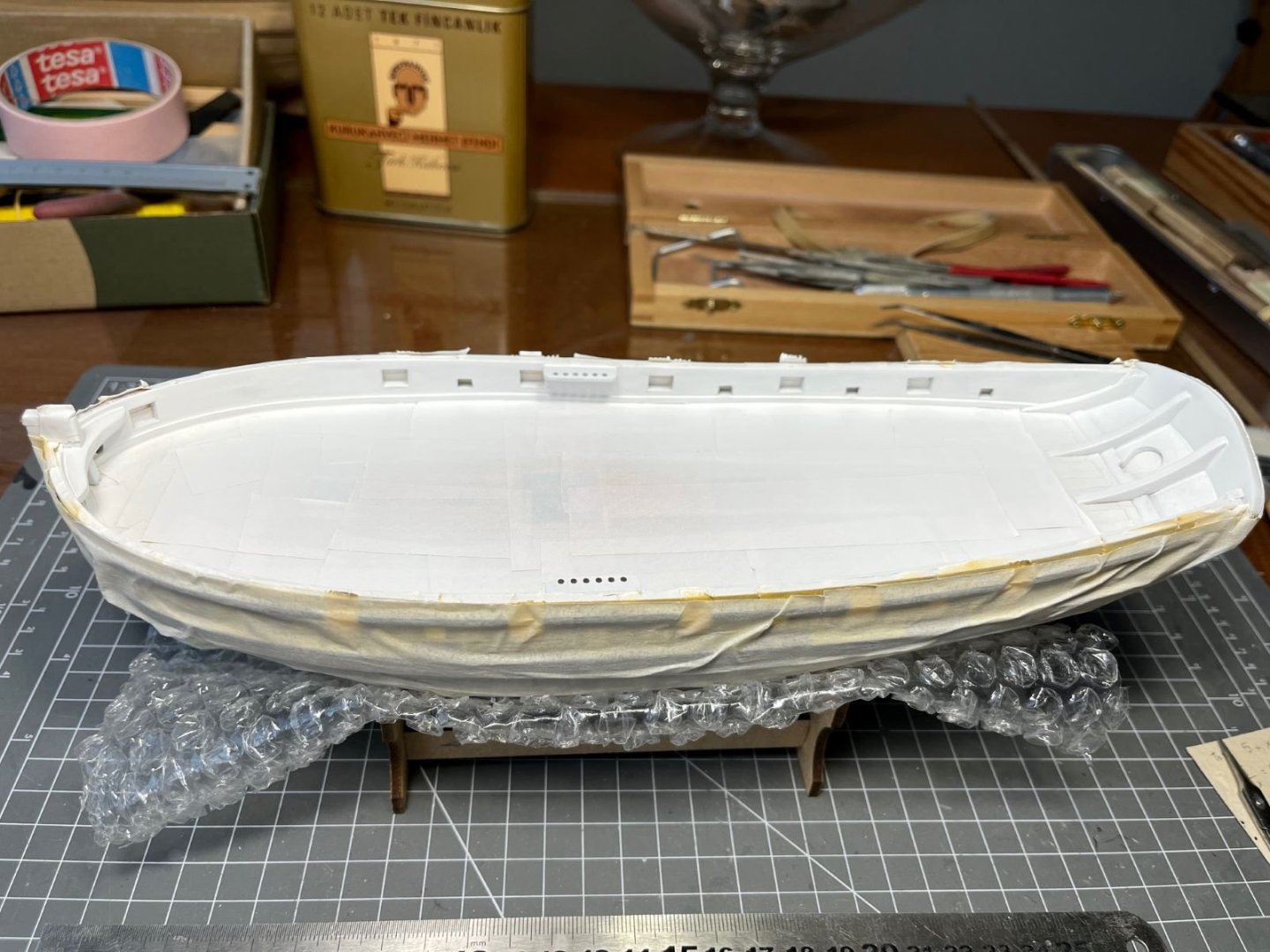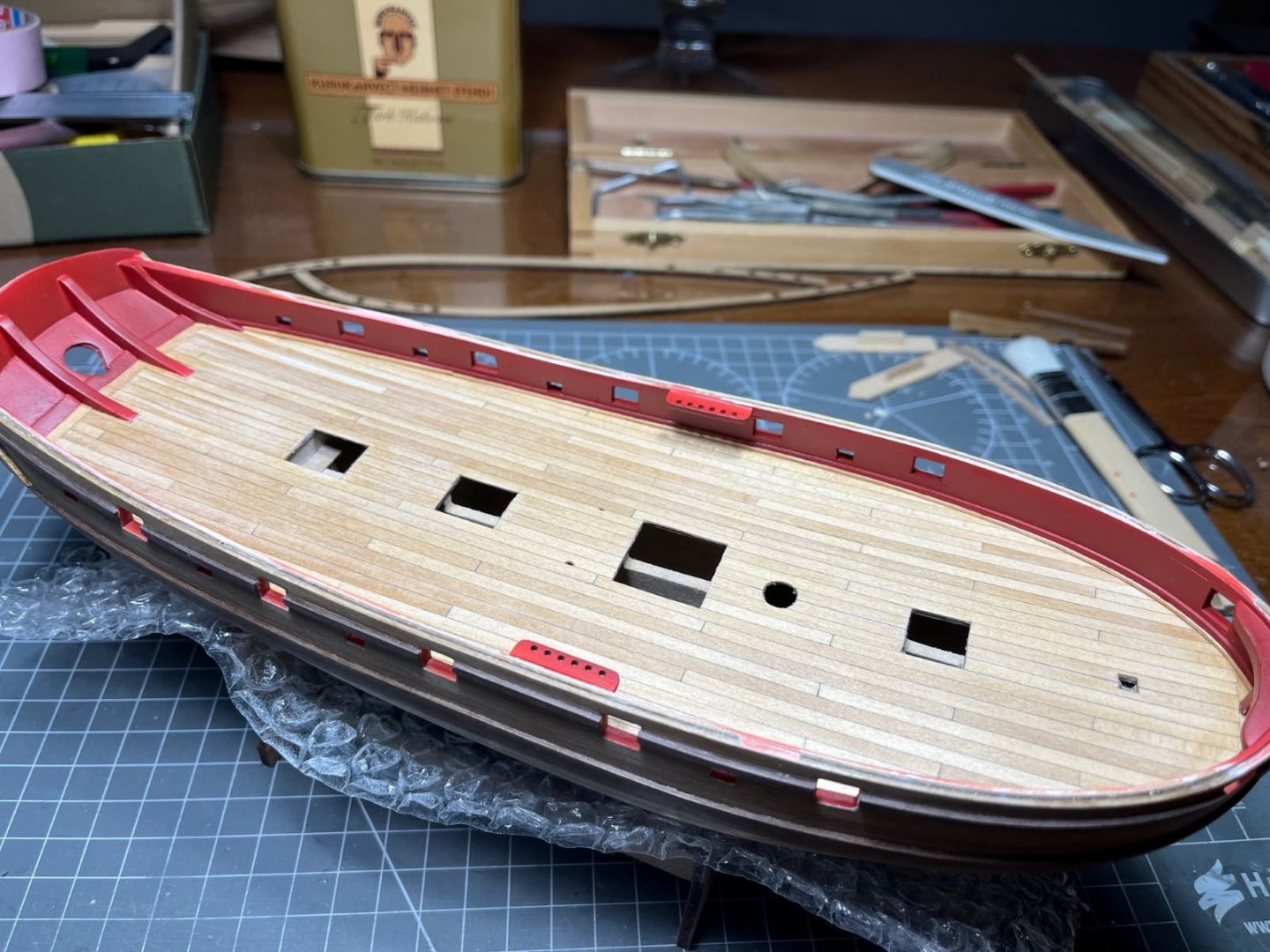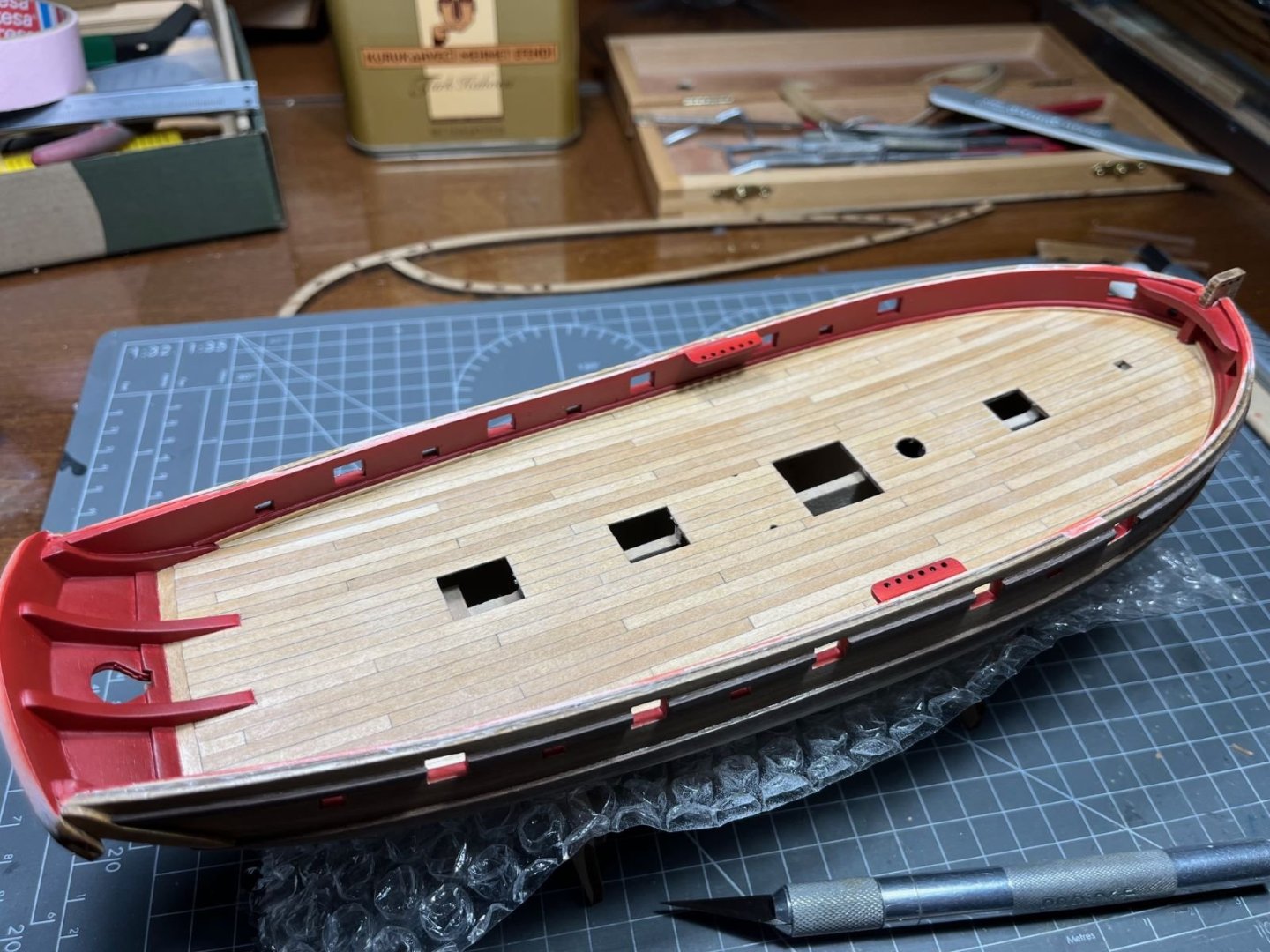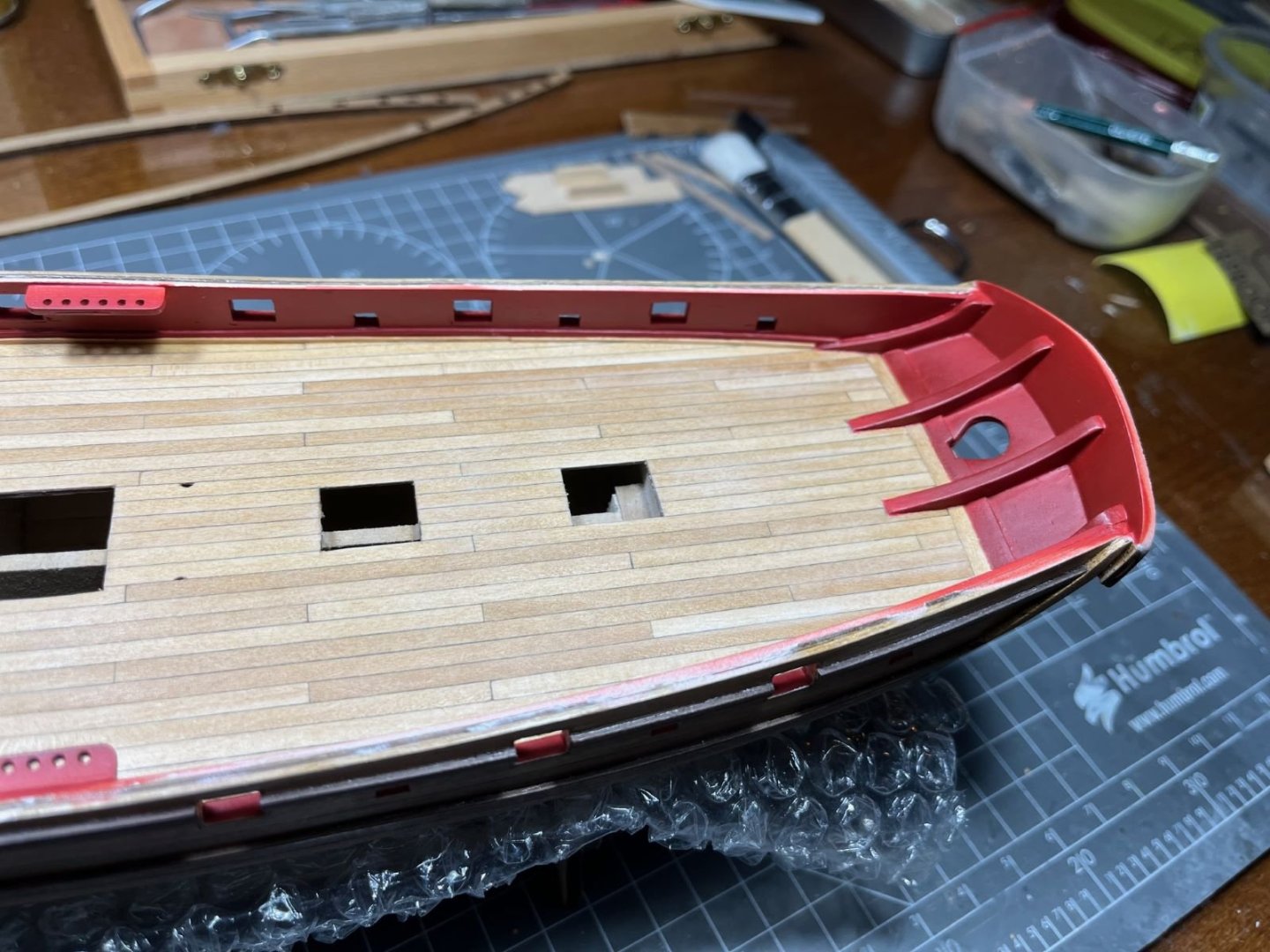-
Posts
747 -
Joined
-
Last visited
Content Type
Profiles
Forums
Gallery
Events
Everything posted by Danstream
-
Indeed, sorry for the misunderstanding, my naval terminology is leaves much to be desired, now I understand why you need nails. In that case, please forget my comment. Cheers, Dan
- 714 replies
-
- lady nelson
- victory models
-
(and 1 more)
Tagged with:
-
@vossiewulf, Unfortunately, I didn't take pictures of the chaiplates, but I have one of the pinrail which was attached with the same system: For the chainplates, I drilled through the thickness of a chainplate side to side with a drill of the same dia. of the tube. The external diameter of these tubes can be found with increments of 0.1 mm: https://www.albionalloys.com/en/brass-tube/ . They have also brass rods, but I like using the tubes better. Here, I find an assortment of these tubes and rods in many hobby shops. Best regards, Dan
- 714 replies
-
- lady nelson
- victory models
-
(and 1 more)
Tagged with:
-
@vossiewulf, your closeup pictures show a level of details which is amazing. Just a suggestion, for the chainplates, instead of nails, I used pins made from a brass tube 0.7mm dia. from Albion Alloys. In this way, I could accommodate them within the thickness of the chainplates and conveniently trim their length as needed. Best regards, Dan
- 714 replies
-
- lady nelson
- victory models
-
(and 1 more)
Tagged with:
-
Back to finishing the hull of my Lady N. I retouched the black paint of the stern and removed the paint from the friezes and the nameplate. I pinned the chain plates on the sides: I installed a shoulder to better support the bowsprit, as seen in other models and also in period models: Finally, bitts and posts for the culverins were glued in place onto the caprails. Next, the catheads will be attached to the bulwarks and the black paint will be finalized. Best regards, Dan
- 87 replies
-
- Lady Nelson
- Amati
-
(and 1 more)
Tagged with:
-
Happy the you resumed this build log. Your sharp work provides lot of inspirational ideas. Looking forward to seeing the continuation of your build. Best regards, Dan
- 714 replies
-
- lady nelson
- victory models
-
(and 1 more)
Tagged with:
-
Thank you Robert, happy that I could be of help, both with my Lady and with my aircraft models. The decals of my F-15 are from Dutch Decals, a company in NL specialized in Dutch subjects, see, f.i.: https://www.scalemates.com/nl/kits/dutch-decal-dd48074-f-15-usafe-hawk-75-dh-82--1220448 usually, their quality is very good. By the way, the orange banner of the fins, is a colorful exception to the specification for using only grey tones to honor the country hosting the squadron. Looking forward to seeing your next builds. Cheers, Dan
- 87 replies
-
- Lady Nelson
- Amati
-
(and 1 more)
Tagged with:
-
Hi all, I went on with finishing the bottom of the hull. I started with taping the waterline with a flexible Tamiya tape. Apparently, according to the plans, the waterline doesn't have to run parallel to the keel, but should form quite an angle with it. After all my efforts to get a reasonable layout of the planks, I feel a bit of a pain in obliterating most of it. I began with filling the most obvious cracks and then I sprayed a white primer to uniform the surface. To render the whitish coat of the hull, I used a Gunze paint denominated H311 Gray FS36622 which I picked from my set of airplane colors (this is a tint which was part of those used by the US Air Force in the past) and which seems to a newbie like me to fit quite well the bill. After removing the masking tapes, there are few spots of overspray to be corrected. In addition the tapes have lifted few spots of the black finish which I will address later. All in all, the result is not bad as it can be seen from the overall views: That's all for now, next I will work on the furniture of the deck. Best regards, Dan
- 87 replies
-
- Lady Nelson
- Amati
-
(and 1 more)
Tagged with:
-
Very nice, I think that your interpretation is correct, certainly much more plausible. I will see what to do when I will be there. By the way, anyone knows where are the poles used for actioning the pawl stored on the deck (or one can assume that they are stored under the deck)? Best regards, Dan
- 39 replies
-
- Amati
- Victory Models
-
(and 1 more)
Tagged with:
-
Hi, I affixed the nameplate of the ship and painted black the stern panels: I must admit that this end of the ship now looks quite spiffy. I finished the cap rails and painted them also black: Now only the white bottom part is missing to complete the main painting steps. To do that, I have first to finalize the rudder with its tiller and hinges. Actually, I didn't like the solution proposed by the kit for the rudder hinges, therefore I gave a try to scratch build my owns. I started by soldering small portions of brass tube to brass stripes: The rod in the picture is the one I will use for the hinge pins. Then, I glued the obtained hinges to the stern post using the brass rod to maintain them aligned. Next, I will prepare the rudder piece to be put on. Incidentally, I am going to replace the tiller with one that I scratch built shown in the picture and that I think looks less obvious than the one of the kit: That's all for now, best regards, Dan
- 87 replies
-
- Lady Nelson
- Amati
-
(and 1 more)
Tagged with:
-
Very nice work with the deck furniture. Looking forward to seeing your way to improve this model. Dan
- 83 replies
-
- Lady Nelson
- Amati
-
(and 2 more)
Tagged with:
-
Good to see that you resumed work on the Lady. Nice elaboration of the companionway, it really looks the part. Cheers, Dan
- 39 replies
-
- Amati
- Victory Models
-
(and 1 more)
Tagged with:
-
Hi, after a final sanding of the hull with a fine grit, I applied a coat of satin varnish which uniformed the shine of the hull and gave the opportunity to finally evaluate the resulting, long lasting planking work. Then, I started painting various details and, after masking, I sprayed a black color on the main wales as suggested by the kit instruction and seen on many models. From my hobby of building plastic model planes, I have a collection of Gunze Mr. Color paints, so I picked up a semi-gloss black paint for this work. These paints spray beautifully and their finish is a bit more resilient than the matt acrylic ones. I am now going to start decorating the stern using the same paint, after the application of the provided photo-etched friezes. Meanwhile, as explained the earlier post, I completed the modification of the bowsprit support: Next, I will have to paint it (red) and the cap rails as well (black). That's all for the moment, I will appreciate any suggestion, best regards, Dan
- 87 replies
-
- Lady Nelson
- Amati
-
(and 1 more)
Tagged with:
-
Hi, I went on with the installation of the cap rails, but I had to slightly extend the length of the provided parts because they resulted to be too short: These are the cap rails finally installed: Following the previous discussions, I tried the bracket that supports the bowsprit: Indeed, it seems that the bracket provides a support that is a bit too high. Therefore, I will modify the provided parts as in the following: I will cut away the foot of each posts along the penciled lines. I will replace them later with new ones of the same shape but with a thinner thickness. Then, I will remove the hatched rectangles so to shorten the height of the posts and the new feet will then be re attached. Best regards, Dan
- 87 replies
-
- Lady Nelson
- Amati
-
(and 1 more)
Tagged with:
-
Gorgeous model Chris, sharp details and beautiful construction. Congratulations, Dan
- 69 replies
-
- fly
- victory models
-
(and 2 more)
Tagged with:
-
Good job on the first and second planking. The second one looks beautiful. I am impressed with how much you manage edge bending the planks in the bow area. I always crack them if I exceed a reasonable entity. Surely another build of yours that I will keep following. Cheers, Dan
- 35 replies
-
- vanguard models
- Adder
-
(and 2 more)
Tagged with:
-
Hi all, some progress on my Lady. After the wales, I finally ended the major works on the hull on its stern area. As I wrote previously, I didn't like to see the ends of the planking strakes because their bond lines looked bad. Hence, I covered those with an additional layer of thin walnut obtaining a configuration that I think looks nicer and cleaner. The sheen is due to the varnish that I used to seal the grain of the wood and that I brushed with a fine steel wool. Next I will brush on a satin clear. Then, I masked the hull to prepare it for painting the inner sides of the bulwarks. To obtain a good uniform base for the red paint, I sprayed a coat of Tamiya white primer, which also revealed few blemishes that had to be filled and smoothed. Finally, I airbrushed the red paint which I obtained with a mix of 80% of Tamiya flat red and 20% of Tamiya flat red brown to make it darker than pure red. To finish the waterway, I added a small wooden strip at the base of the bulwarks. The paints that I used were from the Tamiya acrylic line which spray very well, but they are very matt, almost chalky when dried and their finish is very delicate getting very easily spoiled just by touch. Hence, I brushed on a coat of Humbrol satin clear which made the surface less matt and more resilient. That's all for now, next I will paint the exterior of the hull and install the cap rails. Best regards, Dan
- 87 replies
-
- Lady Nelson
- Amati
-
(and 1 more)
Tagged with:
-
Great model, I hope it happened nothing that you cannot recover. May I ask you how did you brought out the frieze details from the black background? Thank you and best regards, Dan
- 8 replies
-
- Lady Nelson
- Amati
-
(and 1 more)
Tagged with:
-
I didn't comment much, but I am following your build. Dutch vessels are not seen often around, but as other have said, they have played an important role in history. In addition, they have set the standards for others. I have one of these in my wish list. Congratulations for your build so far, it is evident that your modeling skills are improving. Kind regards, Dan
-
Indeed, this is the natural conclusion. I will redo it as well, so I am not bothering more than necessary. I suggest you inspect the pictures of period models of British cutters published in this forum (if you have not seen them yet) to get inspiration about plausible configurations for the new pieces: In addition, I visited the build log of a Lady Nelson model built by @glbarlow, who discussed the problem and re-built the parts in subject (but probably this issue had been treated also by other modelers). You could have a look also on that. Cheers, Dan
- 39 replies
-
- Amati
- Victory Models
-
(and 1 more)
Tagged with:
-
Thanks for the head up Roger! Now it is clear that I need to take out the bowsprit and its support bracket and make some tests. Cheers, Dan
- 87 replies
-
- Lady Nelson
- Amati
-
(and 1 more)
Tagged with:
-
Hi Roger, thanks for your comments. It took a while to me to understand the position of that part and to decide the position of the catheads. The drawings and the pictures are neither clear nor unambiguous. Eventually, I decided that the catheads will be positioned right past (astern) the first openings. I also slightly reshaped that 'V' part making it a bit slimmer. As far as your quote is concerned, I positioned that part in subject just below the the indent for the bowsprit, but I didn't do any fit check with it and with the other supporting superstructures that I haven't yet removed from the package hoping that it will be ok (I know this isn't the correct approach...). I think that I will glue in place the cap rails after having painted the inner sides of the bulwarks. Looking forward to seeing your progress, Dan
- 87 replies
-
- Lady Nelson
- Amati
-
(and 1 more)
Tagged with:
About us
Modelshipworld - Advancing Ship Modeling through Research
SSL Secured
Your security is important for us so this Website is SSL-Secured
NRG Mailing Address
Nautical Research Guild
237 South Lincoln Street
Westmont IL, 60559-1917
Model Ship World ® and the MSW logo are Registered Trademarks, and belong to the Nautical Research Guild (United States Patent and Trademark Office: No. 6,929,264 & No. 6,929,274, registered Dec. 20, 2022)
Helpful Links
About the NRG
If you enjoy building ship models that are historically accurate as well as beautiful, then The Nautical Research Guild (NRG) is just right for you.
The Guild is a non-profit educational organization whose mission is to “Advance Ship Modeling Through Research”. We provide support to our members in their efforts to raise the quality of their model ships.
The Nautical Research Guild has published our world-renowned quarterly magazine, The Nautical Research Journal, since 1955. The pages of the Journal are full of articles by accomplished ship modelers who show you how they create those exquisite details on their models, and by maritime historians who show you the correct details to build. The Journal is available in both print and digital editions. Go to the NRG web site (www.thenrg.org) to download a complimentary digital copy of the Journal. The NRG also publishes plan sets, books and compilations of back issues of the Journal and the former Ships in Scale and Model Ship Builder magazines.


.thumb.jpg.c459ce4140b54c12eddb8eedfd446df3.jpg)


